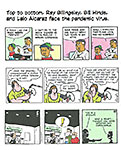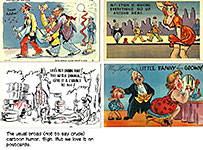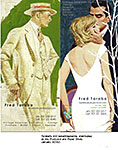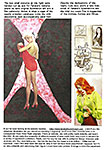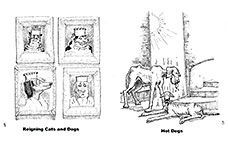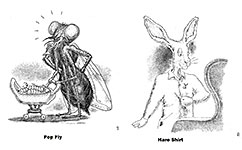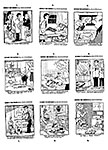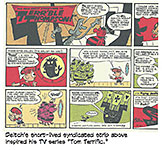 |
||||||||||||||||||||||||||
Opus 403 (May 10, 2020). CONFINED to the Harvey Ancestral Manse for the duration, the Happy Harv had nothing to do for the last few weeks except write Rancid Raves. And so he did. And the result is one of the longest (biggest? most fulsome?) episodes of comics news and reviews, cartoon history and lore on record.
We celebrate Broomhilda’s 50th anniversary, editoonist Pat Bagley’s record-setting 40 years at the Salt Lake Tribune and 35 years of Comic News, the tabloid of editoons. We review Hog Wash and nine Number One comicbooks. We post an essay on “Why Brits Don’t Like Trump” and another one on hate groups in America. We examine coronavirus and the comics, Biden accused of rape, NCS Reuben nominees and three signatures in Dennis the Menace, plus obits for Gene Deitch and Mort Drucker. In order to assist you in wading through all this plethora, we’re listing Opus 403's contents below so you can pick and choose which items you want to spend time on. And we’ve divided this voluminous extravaganza into two parts. No logic involved: we just cut the thing in half and labeled the segments Part One and Part Two. The idea is that if something has a Part One and a Part Two, it’ll seem shorter when you’re reading it because you get to an ending of the first part when you’re halfway through. (Somehow, this makes sense to me.) Here’s what’s here, by department, in order (the longest entries are marked with an asterisk*)—:
>>>>>>>>>>>>>>>>>>>PART ONE<<<<<<<<<<<<<<<<<<<<
NOUS R US San Diego Comic-Con International Cancelled New Yorker Cover Artist Wins Pulitzer for Editorial Cartooning *NCS Reuben Award Nominees and Special Award Winners Reubens Weekend Cancelled Comics and the Coronavirus Sex in Books, As Usual, Banned Zyglis Takes Furlough Tatulli Loses Heart Quarter Million Comicbooks Sold *Veitch Cartoonist Laureate in Vermont *Hate Groups in America The Culture War Explodes
*Broom Hilda Is 50 My Encounter With Elliot Caplin
WARE PANDEMIC AT THE NEW YORKER Kuper’s Borrowing of Winsor McCay
FUNNYBOOK FAN FARE Reviews of Number Ones—: Strange Academy No.1 King of Nowhere No.1 Fantastic Four: Grimm Noir No.1 Backtrack No.1 Cimmerian: Queen of the Black Coast No.1 Criminal Macabre No.1 Killdelphia No.1 Artemis and the Assassin No.1 Decorum No.1
>>>>>>>>>>>>>>>>>>>>PART TWO<<<<<<<<<<<<<<<<<<<
**FOUR DECADES OF PAT BAGLEY
LECHERY AND THE PENILE PROMPT Biden Accused of Rape and Hypocrisy
TRUMPERIES The Idiotic Antics and Other Crimes of the Buffoon in Chief *Why Do the British Not Like Trump?
EDITOONERY The Mock in Democracy
NEWSPAPER COMICS PAGE VIGIL The Bump and Grind of Daily Stripping April Fools Day Strips Easter Pandemic Strips
CORONAVIRUS IN THE COMICS Cartoonists Testify
RANCID RAVES GALLERY Postcards and Paper BOOK MARQUEE Short Reviews Of—: Hog Wash The Comic News : Tabloid of Editoons Is 35
DENNIS SOME MORE A Tale of Three Signatures
ONWARD, THE SPREADING PUNDITRY Trump and History
PASSIN’ THROUGH Allen Bellman Gene Deitch Mort Drucker
Personal Feetnoot: The Pandemic at Home
QUOTE OF THE MONTH If Not of A Lifetime “Goddamn it, you’ve got to be kind.”—Kurt Vonnegut
Our Motto: It takes all kinds. Live and let live. Wear glasses if you need ’em. But it’s hard to live by this axiom in the Age of Tea Baggers, so we’ve added another motto: Seven days without comics makes one weak. (You can’t have too many mottos.)
And in the same spirit, here’s—: Chatter matters, so let’s keep talking about comics.
And our customary reminder: don’t forget to activate the “Bathroom Button” by clicking on the “print friendly version” so you can print off a copy of just this installment for reading later, at your leisure while enthroned. Without further adieu, then, here we go—:
We’re all in it together even if we’re six feet apart. Especially then.
>>>>>>>>>>>>>>>PART ONE<<<<<<<<<<<<<<<<<
NOUS R US Some of All the News That Gives Us Fits
IT’S OFFICIAL: SANDY EGGO COMIC-CON IS CANCELLED For the first time in its 51 years, San Diego Comic-Con International will not convene this year, but it will return in 2021. In a press release announcing the decision, the Con’s sponsor said: "It is the right thing to do. Comic-Con wants to do all we can to fight the spread of this virus and support workers who are on the front line, fighting this battle." Comic-Con International was monitoring the situation in California, with the hopes of the event happening, if by chance the pandemic had come to an end. "Recognizing that countless attendees save and plan for its conventions each year, and how many exhibitors and stakeholders rely upon its events for a major portion of their livelihood, they had hoped to delay this decision in anticipation that Covid-19 concerns might lessen by summer," CCI explained in a statement. "Continuous monitoring of health advisories and recent statements by the Governor of California have made it clear that it would not be safe to move forward with plans for this year." It took some doing to extract the Comic-Con from its July appointment. The Con represents millions of dollars of revenue for the city and the hotels that are signed up for it, so an exit had to be carefully negotiated. The fact that the Con has been coming to San Diego for 50 years undoubtedly helped ease the way to an exit this year. Next year, the Con will convene July 22-25.
PULITZER IN EDITOONING GOES TO ILLUSTRATOR The Pulitzer committee announced all the finalists for the editorial cartooning Prize—in alphabetical order, Lalo Alcaraz, Matt Bors, Barry Blitt, and Kevin Kallaugher—before naming the winner, Blitt, mostly for his New Yorker covers, “work that skewers the personalities and policies emanating from the Trump White House with deceptively sweet watercolor style and seemingly gentle caricatures.” (And a line almost too frail for its work, I say.) Blitt’s work included not only magazine covers but an array of cartoons published exclusively online, the Pulitzer announcement acknowledged. “For nearly three decades in the pages of The New Yorker and, more recently, in a regular series on the magazine’s Web site, Blitt’s political cartoons have parodied, delighted, and informed.” Since 1992, Blitt has contributed illustrations and more than a hundred covers to The New Yorker. The magazine reaped a second Prize with staff writer Ben Taub, who won in the feature-writing category with “a devastating account of a man who was kidnapped, tortured, and deprived of his liberty for more than a decade at Guantánamo Bay. Despite this litany of horrors, Mohamedou Salahi survived with his spirit intact and gained a new friend, a former Guantánamo guard with whom he reconnected after he was released.” In its citation, the Pulitzer Board praised Taub for “blending on-the-ground reporting and lyrical prose to offer a nuanced perspective on America's wider war on terror.” Finalist Alcaraz is cited “for irreverent and poignant cartoon commentary focused on local and national issues from a distinctly Latinx perspective”; Bors, “for cartoons that sliced through the hypocrisy of the Trump presidency, as well as the blind spots of moderate Democrats in a distinct, contemporary style”; and Kallaugher, “Kal,” “for combining classically beautiful cartoon art and incisive wit to create a striking portfolio addressing the Trump administration, international affairs and local Baltimore politics.” Nearby are samples of the work of all the cartoonists.
NCS REUBEN AND DIVISION AWARD NOMINEES And Recipients of Special Awards Five cartoonists are up for the National Cartoonists Society’s Reuben for “cartoonist of the year”: Lynda Barry (alternate weekly cartoons, Ernie Pook’s Comeek and illustrated novels and graphic novels), Terri Libenson (Pajama Diaries, which she discontinued January 4, 2020), Hilary B. Price (Rhymes with Orange, the daily of which is now drawn by Rina Piccolo, who retired her Tina’s Groove), Mark Tatulli (two strips, Heart of the City and Lio’s weird stuff; and children’s books, The Big Break, Day Dreaming et al), and Raina Telgemeier (graphic novels for young readers, Ghosts, Smile, Drama et al). To belabor the obvious—four of the five nominees are women. A huge step at NCS. Three of the five—Barry, Price, and Tatulli— have been nominated before; Price, several times. I don’t think Barry is still doing Ernie Pook’s Comeek; she’s now an Associate Professor of Interdisciplinary Creativity at the University of Wisconsin - Madison. In 2019, she received one of the MacArthur Genius Grants. Telgemeier’s nomination is a happy deviation for NCS: she’s not a syndicated cartoonist but a graphic novelist, which signals that NCS is reaching beyond its membership core to award other deserving cartoonists. After last year’s win by Stephan Pastis (Pearls Before Swine), who either can’t draw or pretends he can’t draw (either of which circumstance makes his winning “cartoonist of the year” a fraud), it’s reassuring to see that all of this year’s nominees can actually draw. The finalists for all the Division Awards in the annual competition are now up at the NCS website. You can see all the voting results here: https://www. nationalcartoonists.com/ 2020/03/2019-ncs-divisional-nominees/
IN ADDITION NCS ANNOUNCED the recipients of several of its special awards that were scheduled to be presented at the 74th Annual Reuben Awards in Kansas City, June 5-7. (But the convention has been cancelled; see below.) ■ Hy Eisman is to receive the Milton Caniff Lifetime Achievement award. The “Caniff” is awarded by a unanimous vote of the NCS Board of Directors. It is given for a lifetime of outstanding and accomplished work to a cartoonist who has not previously won a Reuben. (The single exception was the posthumous award to Charles M. Schulz, who was awarded a unique Golden Caniff for his outstanding contribution to the art form. Schulz had received the Reuben for 1955.) At
the age of 92, Eisman is currently drawing and writing the gags for the Popeye Sunday strip and for the Sunday Katzenjammer Kids. ■ John Glynn, Chairman and Editor at Large at Andrews McMeel Syndication (Formerly Universal Press Syndicate) will be awarded the Silver T-Square. The Silver T-Square is awarded by unanimous vote of the NCS Board, to persons who have demonstrated outstanding dedication or service to the Society or the profession. By press release, NCS said: “We are so pleased to be able to recognize John’s long-standing commitment in contributing his time, energy, expertise and support to both the National Cartoonists Society and its members, and the part he has played in helping to advance the careers of so many cartoonists.” Previous recipients of the Silver T-Square include John’s colleagues John McMeel (2004) and the late Lee Salem, who was presented the award in 2013. Other recipients over the last 72 years include Presidents Harry S. Truman and Dwight D. Eisenhower, James Thurber, Milton Caniff, Walt Kelly, Mort Walker, Herbert Block, Bil Keane and industry stalwarts including Joe D’Angelo of King Features and the Billy Ireland Library’s Lucy Caswell. ■ Garry Trudeau will be awarded the Gold T-Square award, which is presented to a person who has had an outstanding career in cartooning for 50 years. In a press release, NCS said: “We are so pleased to be able to recognize Garry’s stellar career and cannot think of a more appropriate recipient for this prestigious award.” Trudeau will be the 4th person to receive this award in 65 years. Previous recipients of the Gold T-Square include Rube Goldberg (1955), Mort Walker (1999), and Arnold Roth (2018). ■ And Mutts’ Patrick McDonnell will be awarded the Elzie Segar award. The “ Segar ” is presented to a person who has made a unique and outstanding contribution to the profession of cartooning. It is awarded by the NCS Board of Directors in concert with the President of King Features Syndicate in honor of Popeye creator, Elzie Segar. The NCS press release noted: “We are in awe of Patrick’s career spanning multiple disciplines of the craft of cartooning, not to mention his work as an advocate for environmental, humanitarian and animal causes. Patrick will be the 21st person to receive this award in nearly 50 years.” Previous recipients of the Segar are: 1971 Milton Caniff 1972 Otto Soglow 1973 Dik Browne 1974 Russell Patterson 1975 Bob Dunn 1976 Bill Gallo 1977 Mort Walker 1978 Hal Foster 1979 (posthumous) Al Capp 1980 Charles Schulz 1981 Johnny Hart 1982 Bil Keane 1983 John C. Murphy 1984 Fred Lasswell 1985 Jim Davis 1986 Brant Parker 1987 Mike Peters 1994 Fred Lasswell 1996 Thomas Armstrong 1999 Mort Walker
Reubens Weekend Cancelled THIS YEAR’S AWARDS will all be given in absentia. NCS has announced that the early June convention in Kansas City is cancelled. Prez Jason Chatfield adds: “On a positive note, the NCS Board is in the
process of establishing a live streaming option for both the Conference and the
Awards Night. We may even be lucky enough to have an in-person event late in
the More details later. Perhaps the awards will all be given at a safe social distance. Online. Meanwhile, Prez Chatfield, who fled New York City to avoid the plague, got it anyway. Now recovering, he reveals what it's like to get the coronavirus (Spoiler alert: it's horrible) in —what else — a new cartoon, which you can witness here—: https://www.jasonchatfield.com/coronavirus Hereabouts are a couple of Chatfield’s self-caricatures that accompany his account.
THE COMICS AND THE CORONAVIRUS The number of global coronavirus cases is rapidly approaching 2 million, according to CNN on April 15. And totals change daily, always spiraling upward. The number of cases in Russia has surged, said CNN, and Singapore is seeing a second wave of the virus. Germany recorded its highest number of deaths in a single day, even though new infections in the country are significantly down. The U.S. on May 1 marked its deadliest day, and all 50 states now have at least one confirmed death due to Covid-19. As of May 2, the number of known deaths related to coronavirus in the United States passed 66,000. Worldwide, the number of deaths total roughly 240,000. In other words, the United States, the most advanced of the populous nations, has so badly flubbed reaction to the virus—thanks to a self-centered chief executive who thought that by ignoring coronavirus he could assure his re-election— that the total of Covid-19 deaths in the U.S. is more than a quarter of the world’s deaths. The Centers for Disease Control and Prevention and the Federal Emergency Management Agency have reportedly drafted a plan to reopen the country in phases. Despite some politicians, including the Trumpet, champing at the bit to get the economy going again, Dr. Anthony Fauci says the country is "not there yet." In fact, a new study from the Harvard School of Public Health says Americans may need to endure periods of social distancing until 2022 if a vaccine isn't found. Then on the eve of releasing the 17-page CDC plan, Trump suppressed it, saying it was too specific; different localities needed latitude to tailor reopening plans to fit local circumstances. That rings true, of course; but I suspect Trump’s action here is dictated by his own political cowardice—his fear of condoning something that might not work out and that would consequently undermine his re-election hopes. Whatever the case on April 15 when I recorded this, re-opening is proceeding apace nonetheless. By Friday, May 1, more than a dozen states had begun to reopen their economies and public life, even though health experts have expressed concern that a premature opening could lead to a spike in coronavirus infections that would not be detected in official case counts for weeks. Many areas are still seeing the number of cases grow.
And the Comics Industry Is Still in Limbo. Email reports are piling up. And with each new pile, what was true yesterday is no longer true today. But to suggest the flux, here’s a report from Rich Johnston at bleedingcool.com who says that while Marvel Comics seems to be putting itself into mothballs, with editorial staff furloughed and comic book projects put on pause, DC Comics still seems to be going ahead with all pistons pumping. Well, most of them, at least. While some creators have been moved off certain projects such as planned 5G books, with some creators receiving kill fees for the work they have completed, most are being repurposed for other projects. At comicsbeat.com, Heidi MacDonald reported on Diamond CEO Steve Geppi’s appearance as the guest for two hours on Dan Shahin’s Comic Book News YouTube channel on April 29. Geppi spoke about all the current topics. A panelist expressed some worries about the huge piles of other merchandise that have also been held up, to which Geppi responded: “It does us no good for us to ship stuff and have you say you can’t pay for it.” Geppi went into an extended metaphor about restaurants that are closed – they’ll never get back the meals, but comic shop can still sell Batman No.92. “Your customers still want them. There’s a cumulative demand pent up.” In perhaps the bluntest declaration of optimism we’ve heard through all this, Geppi said “I don’t think you can destroy our industry in two months.”
Reports Lunge from Good News to Bad. Working on the edge of rumour and fact as Bleeding Cool often is, said Rich Johnston, we often get flashes of what is actually going on. Like a strobe lamp, we see everything in one fixed moment and are left trying to work out what happened in the dark between then and the subsequent illumination. Sometimes we won't actually know what was going on until it's over and we get to look back and join up all the dots. But that doesn't mean we can't or shouldn't try. Such as with the news that Bleeding Cool received earlier on April 13 that Diamond Comic Distributors has just furloughed the majority of their purchasing department. Regular readers of late will know that Geppi Family Enterprises closed Diamond's doors to new products as a result of the current global situation. They also had to make some staff redundant, but the distributor kept their backorder operations going. We also were recently given the nod that Diamond was expecting to resume new comics distribution in some fashion in mid-May, possibly direct to comic retailers' homes, though some publishers were being asked not to run new solicitations until August. Diamond had also told publishers that they wouldn't be paying their bills, although they have since announced a payment plan. Several essayists have declared the Direct Market dead, or have called for its demise because as matters presently stand, the comics industry is too dependent upon Diamond.
FCBD Cancelled; But Hope Survives. Saturday, May 2, would have been Free Comic Book Day, an annual nationwide event intended to bring die-hards and newbies alike into comics shops. Instead, reported Jake Coyle at the Associated Press, stores were closed nationwide and new print issues haven’t been released since late March, when the industry’s primary distributor, Diamond Comic Distributors, shut down. Normally, some 6 million extra comics are distributed for FCBD and around 1.2 million people flock to stores. For some shops, it dwarfs even Comic-Con, the annual San Diego convention (also canceled ). “We’re going to come out of this with fewer comic shops, but there will be enough that survive that this industry will continue,” said Dan Gearino, author of Comic Shop: The Retail Mavericks Who Gave Us a New Geek Culture. “The question I’m asking is: How big will the culling be?” Joe Field, owner of Flying Colors Comics, is certain the comic shop will abide. “Comic book retailers are the cockroaches of pop culture,” Field says. “We have been through all kinds of things that were meant to put us out of business, whether it’s the new digital world or distribution upheaval or Disney buying Marvel. We have adapted and pivoted and remade our businesses in ways that are unique and survivable.” Steve Geppi, the founder of Diamond, said shutting down distribution was the hardest decision he’s ever made. “When I was a 9-year-old boy reading comics, I never dreamed I’d be the guy to pull the plug on the whole industry,” says Geppi. Diamond is now cautiously preparing to bring the company back online, hoping to fill orders for the third week of May. But restarting will be gradual, and a two-month shutdown has already been enough to potentially reshape the industry. This week, DC began a more robust release of digital comics. Until now, digital comics have been a fraction of the $1 billion industry, accounting for about a tenth of sales. While newspapers have gone digital, most comic readers want to hold the colossal worlds of comic books in their hands. DC also broke its exclusive distribution deal with Diamond to get new issues to shops that are open, adding a pair of new distributors. That move has been debated among shop owners; some say they'd rather wait until Diamond restarts. DC didn't comment. “We want everybody to survive,” Geppi says. “The consumer is going to be the one to decide the fate of the industry.” Meanwhile, Marvel has released a schedule of new comics and graphic novel releases beginning Wednesday, May 27 and extending through July 8. Diamond is resuming operations the week before, for the May 20 release date.“Over the next few weeks, Marvel will keep a balanced release schedule for its comics and trade collections as the industry continues to restart distribution and comic shops begin to reopen and adapt to current social distancing policies,” the company said in its announcement.
CAVEAT: By the time you read this, all of the foregoing may have drastically changed so rapidly are matters developing in one direction or another. I rehearse the foregoing more to illustrate the nature of the crisis than to claim authenticity in the details, which today aren’t as prevalent as they were yesterday.
SEX, AS USUAL, IS BANNED Eight of the 10 most challenged books last year were based on L.G.B.T.Q. subjects or narratives, the American Library Association said in its annual ranking of books that were banned or protested in schools and public libraries. One book told a story about a marriage between two men. Other books on the 2019 list were stories about children and transgender identity. “This year, we saw the continuation of a trend of a rising number of challenges to L.G.B.T.Q. books,” said Deborah Caldwell-Stone, executive director of the library association’s Office for Intellectual Freedom, which compiles the list. “Our concern is the fact that many of the books are age-appropriate and developmentally appropriate books intended for young people, but they are being challenged because they allegedly advance a political agenda or sexualize children,” she told Christine Hauser at nytimes.com. According to the association, Hauser reported, the challenges came from parents, legislators and religious leaders. “Libraries are community institutions, intended to serve diverse communities,” Caldwell-Stone added. “That includes all kinds of individuals and families.” In January, a Missouri lawmaker, State Representative Ben Baker, proposed a bill that would subject public library employees to a fine or jail time for providing “age-inappropriate sexual material.” Baker, a Republican, said the bill was inspired by library programming and events like Drag Queen Story Hour. The Office for Intellectual Freedom said that in 2019, there were 377 attempts to remove books or materials from libraries, schools and universities. Most of the challenges came from patrons, followed by administrators, political and religious groups, librarians, teachers, elected officials and students. The challenges — sometimes made in a written request, sometimes made via public protest — are not always successful, Caldwell-Stone told Hauser. “But the fact that the requests are being made is deeply concerning,” she added. “We find that young people in particular need to find themselves reflected in the books they read. And serving those needs does not take away anything from those people with other viewpoints.” Among the 10 most frequently challenged are—: Sex Is a Funny Word, written by Cory Silverberg, illustrated by Fiona Smyth. This sex-education comic book was challenged, banned and relocated for L.G.B.T.Q. content; for discussing gender identity; and for concerns that the title and illustrations were “inappropriate.” The ‘Harry Potter’ series by J.K. Rowling was challenged over its magic and witchcraft references, for its curses and spells and for characters who use “nefarious means” to attain goals.
ADAM ZYGLIS TAKES FURLOUGH FROM BUFFALO NEWS By D. D. Degg at dailycartoonist.com; April 14 Earlier this year Lee Enterprises bought the Buffalo News. Two weeks after the purchase became final in mid-March, Lee Enterprises announced there would be a series of pay cuts, lay-offs, and furloughs across its chain. On April 13, it hit home as the Buffalo News’ Pulitzer Prize-winning cartoonist Adam Zyglis announced he was taking a two week furlough—: “Starting today, I’ll be taking a 2-week furlough from work and going dark on this forum. Every journalist at the News is being hit with this because of the Covid-19 shutdown.” The furloughs, which will be serialized over the next 3 months, affect 200 members of the staff from newsroom to print shop. And we all hope that it is temporary.
LOSING HEART Fans
of Mark Tatulli’s comic strip Heart of the City doubtless went
looking for their favorite strip for a long time on Monday, April 27. Nothing
like Tatulli’s wispy-haired juvenile was anywhere to be found on the funnies
page. And that’s because another cartoonist began doing Heart that day,
and she is making absolutely no effort to imitate Tatulli’s style. She’s
drawing it her way. How Andrews McMeel, the syndicate that distributes Heart, agreed to let Christina Stewart do such visual violence to the strip is a question that will baffle us for at least the rest of this year. Syndicates are usually very conservative about such drastic things and more than a little reluctant to make changes, particularly in the appearance of a strip. And what Heart fans did when they finally discovered the “new” Heart is anyone’s guess so far. Readers don’t like change and aren’t hesitant about protesting. We’ll see. Stewart studied to be an artist with a focus on illustration, reports Lara Hamdan at news.stlpublicradio.org. After leaving Maryville University, Stewart picked up various jobs in editing and retail, eventually landing a job at Star Clipper, a local comic book store. It was there that she decided to try her hand at making comics. She submited to Ink and Drink Comics, a local monthly gathering of comic fans releasing semi-annual themed short story anthologies, and collaborated on projects with friends. But it wasn’t until she saw comic artist Brittany Williams’ name on a Samurai Jack comicbook that Stewart realized she could make being a comic artist a career. Said Steward, who signs the strip Steenz: “I really do believe that, as corny as it sounds, ‘seeing is believing.’ … I never thought in my head that, ‘Oh, I can’t make comics’ … It was just never an idea that came to my mind. And I think a large part of why that’s true is because I never saw people that looked like me doing comics,” Stewart said on Friday’s St. Louis on the Air. “The second I saw [Williams’] name on [the comic],” Stewart continued, “— I was like, ‘Wait a second. She’s a black woman; she’s making comics — I can do that too,’ and finally it kind of clicked for me too.” She’s taking over for the man who has helmed Heart for the 22 years it’s been syndicated, and he also does Lio, a strip about a kid with weird sometimes frightening powers (see Newspaper Comics Page Vigil down the scroll for a sample). Tatulli used to say that as a youth, all he wanted to do was produce a comic strip; and with two strips to produce, all he did was comic strips. Tatulli has also been doing some children’s books, and my guess is that he finally realized doing two daily comic strips and writing books is more than he should try to do. And he evidently likes Lio and doing kid lit better than Heart. Stewart is now one of the few black women in charge of strips that run in mainstream newspapers. “I’m really happy that I’m getting the notoriety that I have so that can be the same thing [as Williams’ was for her] for other black comic readers,” she said. Heart of the City follows the life of title character Heart Lamarr, who is now in middle school; she was younger when the strip started. Stewart said she was inspired by how activist-minded younger generations are and wants to give Heart more friends of color — and bring teenage issues to the forefront. “[Diversity] is always there in real life,” she said, “so it should be reflected in comics as well. [And] the direction that I’m taking it is definitely more focused on her middle school issues and adventures. “We’re going to talk about friends, how to actually be a good friend to somebody, and gender and relationships and family dynamics — that sort of stuff, all wrapped up in little, humorous vignettes.” In addition to doing the strip, Stewart is a comic editor and teaches at Webster University.
SELLING A QUARTER MILLION COMICS—NEW RECORD? From BleedingCool.com For comic book retailers like Dennis Barger, who said goodbye to dealing with Diamond for monthly comic books, the coronavirus lock-down can be tough, reported Rich Johnston at bleedingcool.com. Customers no longer coming by the store, unemployment and job insecurity reducing disposable income, and even his much-loved Amazon Marketplace prioritizing “essential items” orders at this time, coupled with a reduced postal service— it can all add up. So when opportunities come up, whatever the Governor says, a man's got to do what a man's got to do. And in Dennis Barger's case that means do a deal to sell around a quarter of a million comic books. He posts to Facebook: "What did you do today? Sold 1,000 longs, loaded a semi and headed home, bammm!!!" A thousand long boxes. Each usually contains 200 to 300 comics. That's a quarter of a million comic books he just sold.
RICK VEITCH, CARTOONIST LAUREATE IN VERMONT On
April 2 the current Vermont cartoonist laureate Alison Bechdel officially
passed the laurels to Rick Veitch, the fourth to hold the title, following
Bechdel, Edward Koren and James Kochalka. Because of the pandemic, the laurels were passed via livestream and the ceremony that usually takes place in the Vermont Statehouse and includes a congratulatory handshake by the governor were imaginary rather than real. Vermont is the only state to appoint a cartoonist laureate, reports Pamela Polston at sevendaysvt.com— an idea "concocted," as Veitch put it, by the Center for Cartoon Studies in White River Junction and officially sanctioned. The three-year term is honorary, aka unpaid. Fellow cartoonist James Sturm is cofounder, with Michelle Ollie, of the Center. Sturm explained in an email why Veitch was selected for the laureate. "With his roots in underground comics, Rick has forged a singular career that includes groundbreaking genre work for the big superhero companies, his own creator-owned graphic novels, educational comics, and explorations into the subconscious that would make the great Winsor McCay proud. And just like McCay," Sturm added, "Rick's imagination is commensurate with his stunning craftsmanship." Veitch, 68, has done work for, as he put it, "just about everybody" — most notably two giants of the genre, (pre-Disney) Marvel and DC Comics. "I was fortunate that fantasy and heavy metal were growing," Veitch said. He made enough money, he added, that he could afford to return home and work remotely — which in the pre-digital era meant "via FedEx." Veitch has had roles as an artist and/or writer for some of the iconic characters of the genre, including Swamp Thing, Teenage Mutant Ninja Turtles and Sgt. Rock. About a decade ago, Veitch launched Eureka Comics, which creates cartoons for corporate and education-based clients, including textbook publishers. "They're more open than ever to using comics," he said. "A well-drawn comic — you can't not read it. It engages at an emotional level. And you can get complex information across more simply." In addition, Veitch has published numerous comics and graphic novels of his own. Titles include Heartburst, Brat Pack, The One, Can't Get No, The Big Lie and Army@Love. He has also long journaled, and then drawn, his dreams, turning his fascination into the 1990s series Rare Bit Fiends. Though that publishing venture "ran out of gas in 1996," Veitch said he is renewing it with a new issue. After graduating from Bellows Falls High School, Veitch caught the end of the underground comics era in San Francisco. His first paying gig was making art for Last Gasp's Two-Fisted Zombies. His "real breakthrough," as he called it when interviewed by Chris Mays at benningtonbanner.com, happened with a comic book adaptation of Steven Spielberg's "1941" movie on which he collaborated with celebrated Vermont cartoonist Stephen Bissette. Veitch said everyone was happy with the project except the famous director. "My bones were made at that point," he said. "From there, I always had work for the rest of my life pretty much."
HATE GROUPS IN AMERICA The Southern Poverty Law Center has issued its annual report on hate and extremism in the U.S., from which we extract what follows—: Inclusive democracy, America’s greatest challenge and achievement, is currently in the crosshairs of racism, antisemitism and Islamaphobia—and the intersection of these toxic belief systems is fueling the rise of hate violence and white nationalism in the United States and around the world. Having moved from the fringes of society to the mainstream, these ideologies now frame national narratives and influence electoral outcomes. In 2019, the third year of the Trump presidency, data gathered by the Intelligence Project of the SPLC documents a continued and rising threat to inclusive democracy: a surging white nationalist movement that has been linked to a series of racist and antisemitic terror attacks and has coincided with an increase in hate crime. The number of white nationalist groups rose for the second straight year, a 55% increase since 2017, when Trump’s campaign energized white nationalists who saw in him an avatar of their grievances and their anxiety over the country’s demographic changes. The numbers are a barometer, though an imperfect one, of the size and growth of the movement. ... FBI Director Christopher Wray told the House Judiciary Committee in early February that the agency had upgraded its assessment of the threat posed by racially motivated extremists to a “national threat priority.” ... A majority of domestic terror attacks are “fueled by some type of white supremacy.” ... It is a virulent and profoundly undemocratic ideology that infects our poltical system with hate, fear and resentment. And, as we’ve seen in recent years, the threat of violence is very real. In fact, there’s a growing sector of white supremacists, calling themselves “accelerationists,” who believe mass violence is necessary to bring about the collapse of our pluralistic society. ... We are no more prepared for a backlash of hate violence that could surround the coming 2020 election than we were in 2016. ... Although the experts appear to understand the threat, they remain hamstrung by the Trump administration, which has hired members of hate groups into high-level positions and has on its staff people like Stephen Miller, the senior policy advisor in the White House who has long been allied with anti-immigrant hate groups. ... He is steeped in white nationalist literature and ideas. ...
THE SPLC HAS IDENTIFIED 940 HATE GROUPS in the U.S. in 2019. [While that number represents an increase since 2017, it has actually dropped from the previous year’s 1,020, a decrease explained by the loss of two major groups and their individual chapters. Both groups were essentially one-man operations that fell apart when the man gave up or was arrested and silenced on the Net.] ... [Hate] groups are categorized as Ku Klux Klan, Neo-Nazi, White Nationalist, Racist Skinhead, Christian Identity, Neo-Confederate, Black Separatist, Anti-LGBTFQ, Anti-Muslim, Anti-Immigrant and General Hate. Anti-LGBTQ sentiment within the Republican Party is rising. Groups that vilify the LGBTQ community, in fact, represented the fastest-growing sector among hate groups in 2019—expanding from 49 in 2018 to 70 in 2019, a nearly 43% increase. ... Trump addressed the Values Voter Summit a gathering of religious-right organizations, hosted by the anti-LGBTQ hate group Family Research Council, in October 2019. FRC President Tony Perkins boasted to attendees that with Trump in the White House, “We’re not on the outside looking in; we’re on the inside working out.” Staffers from organizations that vilify the LGBTQ community have been hired by the Trump administration and have influenced and written its policies... [Moreover,] according to a report by Lambda Legal, a third of the more than 50 U.S. circuit court judges nominated by Trump have a “demonstrated history of anti-LGBTQ bias.” ...
THE CULTURE WAR EXPLODES A security guard at a Family Dollar store was shot and killed after he stopped a customer from entering the store because her accompanying daughter wasn't wearing a protective mask. This is life in TrumpCountry where a certain percentage of the population gets belligerent if they can’t exercise their rights as American citizens—in this case, their right to go around without a mask, infecting others. (The masks aren’t to protect the wearer: they’re to protect people around the wearer whom he/she might breathe on.) Makes you wonder if the same rights advocates want to drive on the left side of the road. The so-called logic is exactly the same. When I first read this Family Dollar disaster, I imagined the scene: security guard stops unmasked woman; enraged woman pulls a gun and shoots guard. Nope. Didn’t happen like that. The woman's husband and son allegedly came back to the store later on and shot the security guard in the back of the head. While this an extreme example, experts say it is representative of a concerning trend of customers becoming more aggressive to retail workers or security guards at stores over new rules and restrictions put in place during the pandemic—insisting on their rights even if their rights endanger others. “America’s a free country and I’ll do what I want.” TrumpCountry for sure. If he didn’t create it, he urges it on.
*****
Fascinating Footnit. Much of the news retailed in the foregoing segment is culled from articles indexed at https://www.facebook.com/comicsresearchbibliography/, and eventually compiled into the Comics Research Bibliography, by Michael Rhode, which covers comic books, comic strips, animation, caricature, cartoons, bandes dessinees and related topics. It also provides links to numerous other sites that delve deeply into cartooning topics. For even more comics news, consult these four other sites: Mark Evanier’s povonline.com, Alan Gardner’s DailyCartoonist.com, and Michael Cavna at voices.washingtonpost.com./comic-riffs . For delving into the history of our beloved medium, you can’t go wrong by visiting Allan Holtz’s strippersguide.blogspot.com, where Allan regularly posts rare findings from his forays into the vast reaches of newspaper microfilm files hither and yon.
FURTHER ADO It’s raining It’s pouring The Corona is soaring They’ve dumped our jobs And we look like slobs But we all get up in the morning —Marlene Goodman
BEWITCHED FOR HALF A CENTURY On April 20, Russell Myers celebrated the 50th anniversary of his comic strip about a green-skinned witch, Broomhilda. And the story of the strip’s birth a half century ago is worth rehearsing, so Jimmie Tramel at the Tulsa World did it, and we repeat his words to join the celebration, to wit—: Myers’ desire to see you in the funny pages took root in Tulsa, where his family moved when he was 7. Television wasn’t an entertainment option in Myers’ home when he was a kid in the 1940s. Instead, the thing that captured his eyeballs was the sprawling, colorful comic section in the Sunday newspaper. “I thought I had never seen anything so beautiful,” he said in a recent phone interview. Myers was obsessed with comics as a kid. He said there was a downtown newsstand that carried newspapers from cities all over the country. “A good day for me, I would get on the bus when I was a kid, like 13 or 14 years old,” he said. “You could do that back then and come home alive. And I would go downtown and I would hit the used bookstores (to buy comic books) and then I would go to this newsstand and buy a bunch of these out-of-town newspapers so I could see every comic strip being done and I would take them home and cut them out. We had a room up over the garage and I had them all stuck up on the wall, and I would look at them and study them.” Panel by panel, Myers’ fate was sealed. “It’s kind of a cliche, but I guess you can say you were born to do something.” At 16, Myers made his first attempt at graduating from reader to pro. He submitted a comic strip about a little policeman to a syndicate. “It was terrible,” he said. “Of course it was rejected, justifiably so.” Myers (class of 1956) attended Will Rogers High School during a period when the school’s hallways were a garden for the arts. Future Marvel Comics editor in chief Archie Goodwin graduated the year before Myers. David Gates, Anita Bryant and Leon Russell were a tad younger. Myers shared what he called his “big bragging story” from that era: “In high school we had to write the dreaded junior theme. We were supposed to spend a year doing that theme and list all our notes and footnotes and so forth. Well, I waited until a week before it was due and wrote 40 pages on comics and cartoons out of my head and I got an A-plus and a commendation from the teacher because it was so good.” Myers (he’s in the Will Rogers High School Hall of Fame) studied art at Tulsa University and, after picking up a degree, took the only job offered to him. He began creating greeting cards for Hallmark in Kansas City. He made a nice living. But it wasn’t what he wanted to do. “I wanted to do this comic strip thing.” Myers worked for Hallmark for 10 years — five years inside the building and five as a freelancer. In the meanwhile, he kept pitching comic strips. He said he perfected failure. “I could get on the plane in Kansas City in the morning and get to New York at noon and go to all the six major syndicates and get rejected and get back home at midnight,” he said. “That was an annual trip.” Asked about rejected ideas for strips, Myers said he wiped them from his memory. He said they, like the strip he submitted as a teenager, were justifiably declined. But rejection is still rejection and this was salt in the wound: While at Hallmark, a compadre named Charles Barsotti decided he wanted to do a comic strip. Myers showed him what to do. “Well, he went to New York and sold it!” Myers said “I was supposed to be the ‘expert’ and I didn’t know whether to kill him or myself.” Barsotti’s strip, Sally Bananas, launched in 1969 and continued until 1973. Barsotti is more famous for being a cartoonist for The New Yorker for more than four decades — and he repaid Myers by recommending him to the right person. The right person was Elliot Caplin.
CAPLIN WORKED IN THE COMIC INDUSTRY just like his brother, Li’l Abner creator Al Capp. Caplin came up with the idea for a strip about a witch whose name was Broomhilda. Harvey Kurtzman, a legendary EC Comics and Mad magazine cartoonist, illustrated some Broomhilda samples, but the strip didn’t sell. Caplin met Barsotti at a party and asked if he knew another artist who might be interested in taking a strip for a test drive. Barsotti suggested Myers, who recalled getting a phone call from Caplin on a Friday—: “He said ‘I’ve got this idea for a witch named Broomhilda and that’s really all I have. Can you send me samples of your greeting cards?’” Myers said he was caught off base by the request. “So I sat down over the weekend and, just off the top of my head, did the first six Broomhilda strips and sent them,” he said. “(Caplin) called me back and said, ‘Oh my god, I love them.’ And he ran down the street and sold them. You know the old story of being an overnight success after trying all your life? That’s what it was.” Myers and Caplin struck up a business partnership that lasted 30 years. Myers handled the creative aspects of Broomhilda and Caplin, who died in 2000, took care of negotiations and the business side of the strip. Broomhilda beat the odds just to see print. The fact that she and strip-mates like
Gaylord Buzzard and Irwin Troll have remained in circulation for a half century
is witchcraft-level magic. Myers can’t vouch for the accuracy of this, but he said he heard a stat years ago that out of every 1,000 strip submissions a syndicate receives, one is approved — and the majority of the approvals fail. “And lately I heard the ratio was even worse,” he said. “It was one out of 3,000 or 4,000. I don’t know if that’s true, but that’s what I heard. I don’t doubt it.” Broomhilda has always populated the funny pages in Myers’ hometown. The Tulsa Tribune immediately began carrying Broomhilda in 1970, and it was named the National Cartoonists Society’s top humor strip midway through the decade. The Tulsa World picked up the strip after the Tribune ceased publication in 1992. Some strips get passed from one creator to another over time. Myers has piloted Broomhilda all 50 years. He said he wanted to free up time to do other things about 30 years ago, so he experimented with purchasing ideas for the strip. He bought 30 or 35, but it wasn’t a time-saver because he still had to sort and modify and rewrite the ideas. Buying ideas wasn’t worth the cost or the hassle, so he returned to going solo. (His wife, Marina, handled lettering chores for a few years because “she is better than I am.”) When Broomhilda debuted, her age was listed as 1,500 years old. Asked about Broomhilda’s publication longevity and why she hit a sweet spot with readers, Myers said, “The only answer I have sounds kind of dumb, but I guess they like to read it. That’s all I can think of. You live or die based on how you are accepted by the public. The public has accepted it so far for 50 years. God bless them.” What has Myers done to keep them reading? “I hope I have just made them laugh,” he said. “I don’t have any agenda. I have my own personal political viewpoints, but I don’t put them into the comic strip. I am not trying to teach anybody anything. If people can look at it every day and just kind of snort through their nose and smile, then I have been successful.” This isn’t political, but Myers made a statement when he had Broomhilda give up cigars in the early years of the strip. He did so after receiving a letter from a doctor about Broomhilda’s cigar habit. “My mind is kind of in my parents’ generation,” Myers said. “I love the old vaudeville comics and stuff. When I started out, I was doing drinking jokes and she had a cigar and all that stuff. Times have changed in the last half century, so that went away.” Myers last visited Tulsa for his mother’s memorial service in 2012. He drove by the old brick house of his youth. Except for more trees, it looked pretty much the same. If you’re a cartoonist, you can do your work from almost anywhere. For the last 40 years, Myers and his wife have lived in the same house in Grants Pass, Oregon. [That’s where Donald Duck’s Carl Barks lived.—RCH] Myers is 81 and he has no plans to retire from the strip. [I’m 82 and I retired long ago to produce Rancid Raves.—RCH] Said Myers: “There are days I am tired of it, sure,“but it has just become such a routine part of my existence. It’s just what I do. ... I have longevity on both sides of family and good health, so I’m just going to keep grinding away.” Even if Myers had a change of heart and retired tomorrow, Broomhilda could continue for at least another year and a half because he works ahead and has an inventory of unused strips. There’s an urban legend (or maybe it’s more credible than that) about a cartoonist who waited until crunch time to hit a deadline. Myers said the artist decided to do his work while on a train to deliver the goods. The artist fell asleep and passed his stop. Myers never wanted to be that guy, so he crafts one or two extra strips per week. “Some guys, they have to be under pressure to produce,” he said. “If I’m under pressure, it makes me squirmy, so I like to avoid pressure.” In 1978, when Broomhilda was a relative babe, Myers said this in a Tulsa Tribune interview: “A person wouldn’t be wrong if he said I had the greatest job there is.” Does he still feel that way? “Yeah. You tend to take things for granted. I live here and I look out my window. I look out on a river. People come by and say ‘Oh, that’s beautiful.’ “Well, it is beautiful, but after you sit here for a week or two, you just don’t see it sometimes. It is just there. You take it for granted. But if I sit back and evaluate, I’m thinking, yeah, I’m sitting here in my house in my bedroom slippers and I can work the hours I want and I guess it is about the best job in the world for me.”
FITNOOT. Like Myers, I had a phone call from Elliot Caplin one time, several centuries ago. He started out by explaining who he was, but I interrupted him and said I knew who he was. Then he told me he had an idea for a comic strip and was looking for someone to produce it. The idea? The strip was to be about this hillbilly character who went to the Big City and had satirical encounters with its population. It sounded awfully familiar to me. I declined his offer but recommended Jim Engel, a comics fan cartoonist who designed cartoony stuff for a major commercial outfit. Maybe it was MacDonald’s. I’ve forgotten and since Jim worked out of Chicago, I haven’t seen him in years. As far as I know, Jim declined the offer too.
PANDEMIC AT THE NEW YORKER Chris
Ware is back on the cover of the latest issue of The New Yorker, May 4,
with an elaborate composition entitled “Still Life.” Even a 24-year-old sex worker is attended to. Unable to walk the streets, she takes selfies of herself naked and sells them on OnlyFans. “The result of the whole production,” says Francoise Mouly, the magazine’s art editor, “is a fractal portrait of the city, and Chris Ware’s cover is a fitting complement.” As usual with a Ware portrait, there’s plenty to contemplate and ponder over. And Ware wrote about his relationship to New York—: “Having lived in Chicago for thirty years, I’ve only ever been a visitor to New York, but I love it like no other city. Teeming with unpredictable people and unimaginable places and unforeseeable moments, life there is measured not in hours but in densely packed minutes that can fill up a day with a year’s worth of life. “Lately, however, closed up in our homes against a worldwide terror, time everywhere has seemed to slur, to become almost Groundhog Day-ish, forced into a sort of present-perfect tense—or, as my fellow New Yorker contributor Masha Gessen more precisely put it, ‘loopy, dotted, and sometimes perpendicular to itself.’ “But disaster can also have a recalibrating quality. It reminds us that the real things of life (breakfast, grass, spouse) can, in normal times, become clotted over by anxieties and nonsense. We’re at low tide, but, as my wife, a biology teacher, said to me this morning, ‘For a while, we get to just step back and look.’ And really, when you do, it is pretty marvelous.”
IN THE PREVIOUS ISSUE, Peter Kuper appeases cartoon editor EmmAllen’s passion for “long form” comics—in this case, a full-page comic strip—which he offers as a invocation of Winsor McCay’s famed series “Little Sammy Sneeze.” In episode after episode, Little Sammy sneezes with such velocity that he overturns or destroys major elements in his surroundings.
In Kuper’s take on the classic comic, the sneezer is the Trumpet. Each panel in the comic strip represents a telling date in the progress of our life parade with the coronavirus, the Trumpet reacting as he did in real life—ignoring all the red flags and saying all the things that Trump actually said. Until finally, like Little Sammy, he sneezes, and blows the parade—our lives— apart. Then a cop takes him home and recommends that he be removed immediately. But the Trump child has the last word, bragging about himself. The comic strip is a deft portrayal of the Trumpet’s failures. When I first looked at it, I thought Kuper was deploying imagery that mimicked McCay’s Little Nemo in Slumberland. But the Sammy Sneeze parallel is better for Kuper’s purpose—the sneezing. Having
settled that demurer in my own mind, I went looking for examples of McCay’s Little
Sammy to post by way of fleshing out this article. A couple of them we
passed by a few paragraphs ago. And then I encountered the episode posted near
here. It is exactly, line-for-line, the image that Kuper appropriated for his
full-pager. Kuper ends the strip with an appropriate annotation in the lower right corner. Cartoonists who borrow other cartoonists’ devices signal their indebtedness by “apologizing” to the colleague from whom they’ve copied something, lettering the apology onto the cartoon next to their own signature. Instead of apologizing, Kuper might have more accurately lettered “Thanks to McCay for the drawing.” And, speaking of Kuper, we’ve posted nearby his celebration of Earth Day and Rachel Carson’s Silent Spring.
BABIES Humans are the only animals that have children on purpose with the exception of guppies, who like to eat theirs.—P.J. O’Rourke It sometimes happens, even in the best of families, that a baby is born. This is not necessarily a cause for alarm. The important thing is to keep your wits about you and borrow some money.—Elinor Smith Instead of having a baby, why don’t you get a tattoo of a baby first, and see how that works out for six months to a year, and then see if you’re ready to have a baby.—Chelsea Handler I don’t need a baby growing inside me for nine months. For one thing, there’s morning sickness. If I’m going to feel nauseous and achy when I wake up, I want to achieve that state the old fashioned way: getting good and drunk the night before.—Ellen Degeneres
FUNNYBOOK FAN FARE Four-color Frolics An admirable first issue must, above all else, contain such matter as will compel a reader to buy the second issue. At the same time, while provoking curiosity through mysteriousness, a good first issue must avoid being so mysterious as to be cryptic or incomprehensible. And, thirdly, it should introduce the title’s principals, preferably in a way that makes us care about them. Fourth, a first issue should include a complete “episode”—that is, something should happen, a crisis of some kind, which is resolved by the end of the issue, without, at the same time, detracting from the cliffhanger aspect of the effort that will compel us to buy the next issue. A completed episode displays decisive action or attitude, telling us that the book’s creators can manage their medium.
Strange Academy No.1 (Marvel) is by Skottie Young (words) and Huberto Ramos (pictures). First, we meet Emily Bright as a young girl, then as a somewhat older girl (teenager). Emily has mysterious powers (she brings her pet dog back to life after it is hit by a car), and in the midst of her encounter with an angry tree, Emily is joined by Zelma Stanton, another person with powers. Zelma persuades Emily’s parents to let Emily go to a school for people with magical powers. The rest of the book is devoted to introducing Emily’s classmates at the Strange Academy. These are weird people. Some have heads of animals; some are giants or have horns growing out of their heads or heads that are jack-o-lanterns. Emily meets her roomie, a fairy named Shaylee Moonpeddle. At the end (on orientation day) Doctor Strange shows up, and they all gang up on an evil creature of light and power, a “throzil.” Several
minor episodes accompany some of these introductions in order to display the
characters’ powers. But the chief episode in the book is the opening sequence
wherein Emily discovers she has strange powers but can’t control them. It The book is beautifully drawn, no question. Ramos is a master of luscious artwork. The book’s chief flaw is that there are too many characters, each with his/her own eccentric power. No reader can possibly keep all of them in mind as distinct personalities. It’s simply too much. And while all the introductions are going on with accompanying demonstrations of powers, we lose sight of Emily altogether. And she is presumably the heroine of the tale. The book ends but without any noticeable cliffhanger. To the extent that we want to sign on for No.2, it’s because all of this book is building suspense by provoking the question: okay, all of these characters are fine, now what? Hereabouts are some pages, displaying Ramos’ mastery.
THE
BEST PART of King of Nowhere No.1 (Boom Studios) is the cover,
which I’ve posted, with one of the interior pages, near here. Denis’ encounter with the six-armed guy is an episode that is crucial: it convinces Denis that he’s not dreaming. Their fight is interrupted by the arrival of the sheriff, a fairly normal-looking guy with an eyepatch named Tucker, who invites Denis into his office. When Tucker’s daughter barges into the sheriff’s office announcing, “Big guys are back on the south side,” Tucker recruits Denis to help discourage the big guys. Thereupon ensues the book’s notable complete episode—: Denis, the sheriff, and a horned female deputy named Sheila shoot and kill or chase off a bunch of giant iguanas, “the big guys.” “Welcome to Nowhere,” the sheriff says to Denis, who has proved himself adept enough with a rifle. And he may need it again. Then the book closes with a 3-page incident: a man wearing glasses shoots and kills the man with the deer’s head after asking him if he knows Denis. The story, by W. Maxwell Prince, is just that puzzling. Things happen for no apparent or logical reason. Tyler Jenkins drew the book, and his style of illustration suits the story: it’s haphazard, fine lines outlining figures that Jenkins then splashes with black ink. Sometimes the black defines a shape; sometimes, it does not. Sometimes the blacks are shadows; sometimes, they’re not. Wonderfully confusing stuff.
In Fantastic Four: Grimm Noir No.1 (Marvel) by “storytellers’ Ron
Garney and Gerry Duggan (the former probably doing the drawing;
writers’ names are usually listed first on covers, and that’s where Duggan
appears), Ben Grimm is having nightmares involving a beautiful singer named Rosemary
who lives across the street from where he and Alica live. He dreams But Grimm pulls himself together (as he puts it) and the two fight. More than two: D’Spayre musters a host of other demons, but Grimm finally emerges victorious, and Rosemary is restored to her life in the apartment across the street. With Grimm slipping into a nightmare and then out of it, the narrative is confused at best. We just go with the flow. But it is the pictures that attracted me to this book. The cover, posted near here, is nothing short of spectacular, and Garney (if it is he) occasionally resorts to stark black-and-white patches at various places throughout.
Backtrack No.1 (Oni) by Brian Joines (words) and Jake Elphick (pictures) introduces us to Alyson Levy, famed as a “wheelman,” the person who drives criminals away from the scene of their crime. She has given up the outlaw life and now is wallowing in self-pity, drinking to excess and vomiting. She is approached by Casper Quellex, who offers to reboot her life if she’ll run a race and either win it or qualify. She resists but finally agrees. Turns out there’s more than one race. She wins the first race, thereby qualifying for the next, which is much longer: 30 miles to the parking lot at Dodgers Stadium. She and other drivers in the race speed off and soon run into a dinosaur and several large shiny menacing objects. As many as survive this encounter dash off to a “checkpoint,” where they all sort of catch their breath before going on with the next stage of the race. It’s not clear how long this succession of races will go on. And the drivers all want to know who’s “won.” “Is this some kind of sci-fi finish line?” one asks. And then, one of the drivers discloses that it’s all “a game” engineered by Quellex. “Now
he’s going to bounce you lot up and down the timeline, chipping
away until whatever mangled piece of meat Several completed episodes—Levy’s first encounter with Quellex, the first race—establish her as a gutsy heroine, andwe don’t need much more than that. The book ends with the aforementioned speaker asserting that he’s run Quellex’s races before. How that should be a cliffhanger enough to prompt my purchase of the next issue is puzzling. But it is. Elphick draws with a heavy outline, sprinkled with finer lines for aspects of the picture within the bold outline. It’s attractive, and Joines’ story is a challenge: racing automobiles can be exciting in motion pictures, but on the page of a comicbook, it makes for boring pictures. How often can you draw the picture of a car and make it interesting? Elphick manages it but just barely.
HOW CAN WE RESIST buying the first issue of Ablaze’s The Cimmerian: Queen of the Black Coast with a cover like Mirka Andolfo has produced?
Sexist though it surely is, sex is what the Queen of the Black Coast is to our old champion, Conan, and vice versa. “Uncensored” it says across the top of the cover, and so it is. Once Conan meets Belit, their sexual adventure is more spectacular than their other exploits. And Pierre Alary is adept at both kinds of action. His
style is borderline cartoony, but he turns that into meaningful menace and
danger through the sheer energy of his pictures. The book opens with Conan escaping the courtroom where he is being tried for his part in a tavern brawl the night before. He confiscates a mount and goes galloping—flying, even—out of the city. In the bay into which he and his horse splash down, he climbs aboard a ship, where his penchant for violent action endears him to the skipper, Tito. They set off, looting and pillaging until they encounter Belit, who is impressed with Conan enough that she takes him as her “king” (lover) and they go merrily on, looting, pillaging and canoodling to a fare-then-well. When Belit’s ship is attacked by a giant serpent, Conan successfully cuts the thing in half and saves the day. Then, they set sail up the river to sack an ancient city. Conan proves himself in several episodes; Belit, likewise. And the promise of more action (and sex in the nude) will bring me back for the next issue.
With Criminal Macabre No.1 (Dark Horse), writer Steve Niles returns to macabrity, this time illustrated with liquid bold lines by Gyula Nemeth. In the opening sequence, Cal McDonald, a vampire hunter, is rescued from some riffraff thugs by his major domo, Mo’Lock, a spectural being with red eyes, who takes him home, cleans him up, and wants to know what happened. Cal says he was out scouring the city for work, when he saw a beautiful woman and followed her into a nightclub, teeming with vampires. He ignores this temptation, however, in favor of another: he allows himself to be taken to see “the boss.” The boss turns out to be the lady he was following. Victoria, a vampire. They talk all night, and Cal is falling in love. At dawn, Victoria must leave until nightfall. They agree mutually that they might meet again. Back home, Cal ponders about Vicky, and then when he opens the front door to answer a knocking, he barely ducks a shotgun bullet. End. The most complete episode in the book is the all-night conversation with the vampire Victoria. We learn that our vampire hunter, Cal, is susceptible to feminine wiles. And he seems charitable minded enough—not at all bound by the usual vampire hunter compulsions. Well, Vicky is beautiful. And she’s explained that she has a blood donor so she won’t make a lunge at Cal’s throat. This
could be fun, enlivened by Nemeth’s artwork. His undulating bold/fine linework
is a pleasure to watch. He betrays a weakness for close-ups with eyeballs, and
even those are fun to look at. And we must find out who (and why) Cal’s being shot at. But I did not return in time to learn that. The next issue I picked up was No.4, the last of the series. By then, Cal and Victoria have had whatever affair Niles wants for them. And then Cal discovers a vault of dead vampires and dashes off to Victoria’s office to learn her fate. He runs into a man holding a cross-bow (arrows to the heart being one of the ways to kill a vampire) who introduces himself as Larry Van Hesling, a vampire killer. They go off vampire hunting. They find a concrete block of a building. Inside, they find people in cages being drained of their blood. These are the donors Victoria spoke of. Scarcely volunteers. As Cal and Van Hesling open the cages and try to help the blood donors, Victoria suddenly shows up, red-eyed and fanged. She tears off Van Hesling’s head, and Cal, confronting her with her lie, pulls his gun and shoots her six times in the face, quite destroying it. Six bullets are enough, as it turns out, to kill her. Cal goes back home. Mo’Lock tells him he’s sorry for his loss. And Cal decides to just sit there and wait for something to happen. Suddenly, he notices a fanged skull on the floor. “What the hell is this thing?” he asks himself. End. The moral to the story: don’t fall in love with a vampire.
Killdelphia No.1
(Image) is notable chiefly for the painterly approach to illustration by Jason
Shawn Alexander. This issue ends with a 4-page demonstration of how he
produced the cover drawing—er, painting. First, a pencil sketch; then the
sketch fleshed out with ink and acrylic; then background cleanup followed by
the addition of color. Fully half of every picture Alexander produces in the
book is drenched in black shadow. The book opens with Jim Sangster, a detective, musing about his hatred for his father, who is dead, his death freeing Jim to be himself. At last. Jim’s father, also a detective, is clearly a problem for our protagonist. He finds his father’s journal, in which Sangster Sr. recorded aspects of his investigation into serial murders in his city. The medical examiner believes the dead people died after being bitten and infected with yellow fever. A side issue: did John Adams (yes, that John Adams, one of the founding fathers) have yellow fever? Sangster Sr. goes looking for Tevin Thompkins, reportedly a vampire, who is either the serial murderer or can shed light on the matter. Sangster Jr. later finds in a dark and unwholesome alley his father’s body, murdered—perhaps by Thompkins. Junior is investigating the same series of serial murders that his father was investigating. He talks to the medical examiner and then finds a bunch of corpses, the work of the serial vampire killer. Junior runs off, and while writing about all this, he recalls the death of his mother, and he goes to the graveyard and digs his father’s body up—and finds, in the coffin, his father grinning at him and saying, “What took you so long, boy?” What with the darkness that Alexander ladles into every picture, it’s difficult to tell Senior from Junior; also, they’re black, African American, which only increases the difficulty. And that difficulty complicates writer Rodney Barnes’ already mysterious tale that involves four time periods: first, Junior’s writing about his life; second, his investigation of the murders; third, his father’s investigation of the murders; and fourth, Junior’s relationship with his father. And each of these sometimes seems to blend into others. The only readily discernible completed episode is Senior’s—when he goes looking for Thompson and fires his gun at someone in the shadows. It shows Senior’s dedication to finding the truth—the villain. And it rescues Barnes’ story from its otherwise inherent confusion: we stick with Senior long enough to know it’s him. But this is a spook story, and the thing that will bring lovers of this genre back is the desire to know if that’s really Junior’s father grinning out at him from his coffin. Or is it some sort of vampire hallucination? In short, it’s the spookiness that’ll bring ’em back.
Artemis
and the Assassin No.1
(Aftershock) is a slickly drawn but largely ineffective tale of a timeless
avenging angel. Meghan Hetrick and Francesca Fantini have
produced crisp, clean art for a story that might have been better rendered in a
more shadowy manner. Writer Stephanie Phillips starts us off in Russia
in 1916 when a hooded bowman (actually, as it develops, woman, bow-woman) stops
a horse-drawn carriage and kills the driver and a guard and the occupant. The archer then presses a button on her arm gauntlet and is transported through time to another location that looks mid-1900s. The story soon shifts to Vichy France in 1944, a country still occupied by the Germans toward the end of World War II. There another woman assassin, Virginia, shoots and kills a Nazi from ambush. She rejoins her resistance comrades, they all cheer, and she retires to her room, where she removes her artificial leg. Then a young man knocks on the door, and when she lets him in, he tells her that the Allies are going to land at Normandy. Then he’s killed, shot from behind—or gassed in some mysterious way. Virginia leaps to the door (on her one leg?) and is confronted by —Artemis, the female assassin from 1916 Russia. End. The only completed episode in the book is the Russian incident, which ends in mid-twentieth century with Artemis in a quarrel with a young man who criticizes the timing of her assault on the horse-drawn carriage and drops tantalizing hints—Was she responsible for a hit on Atilla the Hun? Did he save her from “the flood” that Noah floated away on?. She stalks off, saying, “Who do you need me to kill?” The episode reveals that Artemis, also called Maya, is an assassin who lives through the ages, apparently under contract—to whom? She is efficient and a little short-tempered. Not a likeable personage. The book has too much puzzlement. None of what Artemis does is explained. And she is not an attractive heroine. In the book’s closing scene, her bow and arrow is targeting Virginia. But why should we care? For either of them? And if we don’t care, we aren’t likely to come back for No.2. The book ends with a 4-page episode seemingly unrelated to the story. In it, Maya is with some other archers as they shoot at a target. Their instructor seems satisfied when Maya says she sees her target without emotion. What she wants is a mission. And she believes she’s ready. Her instructor sends her to kill someone—by which, she’ll demonstrate that she’s ready. This episode is also continued to No.2 of the title. Okay—so Artemis is an ambitious assassin. Still not enough. Still not likeable.
Decorum No.1 (Image), although featuring another assassin (must be the season for them), is much more than that. Written by Jonathan Hickman and drawn by Mike Huddleston, the book is part text, part diagram, and only a few pages of comicbook storytelling. The text and diagrams and numerous almost blank pages set out to describe life on the Preserves, self-repairing, autonomous terraformed bubbles, over ten thousand of them, most of which died out or were destroyed during the crusades of the Singularity. After
a text introduction that makes only marginal sense, we get several pages of
comicbook panels that display life on one of the Preserves, but since the
beings depicted are not all humanoid and their speech balloons are filled with
symbols not words, we can scarcely understanding what’s happening here except that
we are being shown life on one of the Preserves. The book is bigger than most comicbooks—52 pages. Halfway through, we meet a human-looking woman, Neha, who is a courier negotiating with a frog-like being. After four pages, she agrees to deliver the packet, whereupon the book once again descends into high-fallutin’ text and diagram. The
rest of the book, Chapter Three—all in black-and-white comicbook pages with red
accents— introduces us to a tall, severe-looking woman who speaks in a
convoluted high-fallutin’ argot that reminds me of pretentious academic thesis
writing. When
Neha arrives, Imogen opens the package and removes a large red sort-of gem,
which is a weapon that Imogen uses to wipe out Doman and his henchmen in two
pages of bloodless killing. Then Imogen turns to Neha and says, “What are we going to do with you?” The book then ends with three blank pages, the bottom of the last inscribed “Next Issue.” This is undoubtedly the strangest comicbook I’ve ever beheld. Whether Hickman can persuade Image to produce more issues on the same scale as this one remains to be seen. The second issue may be out by now, but I haven’t seen it; it probably arrived at my comicbook shop after the coronavirus shut-down. The only sequences in the book that are complete and comprehensible are those introducing Neha and then, later, Imogen on her punishing errand. Neha emerges as a thoroughly likeable human with a determined inclination. Imogen proves to be effective despite the lofty pretension of her lingo. It’s enough. We want to know what will become of Neha now that Imogen has turned her unforgiving eyes upon her. But whether all the off-world trappings of blank pages and diagrams and text explanations are essential to our enjoyment is a matter of personal taste. And mine is convinced that all those pages herein are a waste. But I applaud the complex effort to create with pictures, diagrams, and text a scientific-looking world through which to romp with a story. A noble effort and, as far as I can tell, a successful one.
>>>>>>>>>>>>>>PART TWO<<<<<<<<<<<<<<<<<
FOUR DECADES OF BAGLEY ISN’T NEARLY ENOUGH We Want More Pat Bagley has drawn an editorial cartoon for the Salt Lake Tribune almost every day for forty years—a feat no other full-time staff cartoonist in America can equal. Last fall, the paper staged a wingding of a celebration at the Rose Wagner Performing Arts Center on Thursday, November 14. After hearing what he had to say (what he did with the cow he won in France at a cartoon festival, f’instance) (no, I don’t know: I wasn’t there), the party re-convened at Squatter’s Pub across the street for appetizers, drinks, and a signed copy of 40 Years With Bagley; tickets, $100. The price alone suggests that he is something of a beloved institution in the city. I met Bagley in April 1991, nearly 30 years ago (before he became an institution). I was passing through Salt Lake City on a convention site inspection tour. As had become my practice in those days, I asked Jud Hurd, editor/publisher of Cartoonist PROfiles, if he knew a cartoonist in Salt Lake City who I could interview for his magazine. He suggested Bagley, and one afternoon when I’d finished inspecting hotels and other convention facilities, I called on Bagley. “Humor is the hook,” Pat said during our conversation. “That’s what gets people to come back— to turn to the cartoon before they read Ann Landers.” We were talking about the function of the editorial cartoonist. Is he reporter or crusader or jester? In Bagley’s view, he’s a little of each. “My job is to do, I think, three things,” he said. “One is to inform, and that can be done with an editorial cartoon that doesn’t really take a position on either side of the issue. The issue may be obscure and needs clarification, so you draw a picture to clarify what’s going on. Another thing a cartoon can do is to persuade. As I tell elementary school people when I talk to them, I’m out there trying to get you to see things my way. But you have a mind of your own, and you make up your own mind. And the last thing is to entertain, to be funny, humorous. And that’s the hook.” We were sitting in Bagley’s office, a cubicle of 5-foot-high walls snuggled up to a bank of editors’ offices on the second floor of the Salt Lake Tribune building in downtown Salt Lake City. Bagley’s drawingboard was positioned diagonally in the corner away from the windows that overlooked South Main Street. Soft-spoken,
articulate and relaxed, Bagley sat on the stool in front of his drawingboard.
He was dressed casually— plaidish sport shirt, jeans, running shoes— and his
blond hair and short beard accentuated the kind of ruddy complexion that skiers
and other sorts of outdoorsmen have, the kind that radiates health and fitness
and makes sedentary people like me wince with envy. A lot of his cartoons have been collected in books. Many of them are cartoons the Tribune has rejected because they are critical of the Mormon culture, and Salt Lake City is the Mormon capital of the universe. Amazingly perhaps, despite his making snide remarks about the Church of Jesus Christ of Latter-day Saints (LDS), his books are best-sellers in that region. “You don’t deal with the sacred stuff,” Bagley explained in an interview with Shauna Lake at kutv.com, “—but you can deal with the cultural stuff. And some people have a hard time distinguishing between the two. I mean, there are those who think green Jell-O is somehow sacred, right?” Working in the community dominated by LDS imposes certain constraints upon the editorial cartoonist, but Bagley sees quite another side to his situation. “Doing political cartooning in Utah is not ... hard,” he said (pausing to select the most appropriate descriptive term), “because there are things that come up in Utah consistently that made good cartoons. This latest issue about the abortion controversy is the kind of thing Utah puts on itself all the time. The state legislature is very moralistic, and they see themselves as being in the forefront of the fight against creeping moral decay in America. So I can count on them at least twice a year to give me something to do.” “Something that will keep you supplied with material for weeks, you mean?” I said. “Yes,” he said grinning impishly. “It’s kind of like shooting fish in a barrel.” But the blessing is not unalloyed. “The
Church has a huge influence here,” Bagley went on. “And it’s a two-edged sword.
It’s good in some respects in that I can do cartoons that wouldn’t make any
sense anywhere else because the humor is sort of ‘in the family.’ If you’re
from Utah, you understand what I’m getting at. On the other hand, the thing
that’s bad is that the Church wields such influence in the state that the paper
is hesitant to publish a lot of those kinds of cartoons. My guess is that one
of every three that have to do with the LDS Church get printed; the others
never see the light of day.” A lot of those “others” have been published by Signature Books of Salt Lake City in two paperback collections of Bagley’s cartoons: Treasures of Half-Truth in 1986 and Oh My Heck in 1988. The books are unusual in several respects. First, their content breaches decorum (joyfully— with such carefree abandon that there’s a kind of innocence about it). The cartoons in them are almost all based upon aspects of the Mormon culture, and joking about religion—particularly an oft-persecuted sect—was, until quite recently, a firmly held taboo almost everywhere. Secondly, understanding the cartoons sometimes requires special knowledge. The jokes are so specific to tenets and practices of the Mormon religion that many of them cannot be understood without knowing something about LDS. Finally, in spite of these seeming obstacles to success—or, perhaps, because of them— the books sell very well. Probably better than most collections of editorial cartoons. Bagley said he’s heard that Oliphant’s annual collections sell about 7,000 copies; each of Bagley’s two books has sold better than 15,000. “The Mormon Church played a huge role in my life,” he continued by way of explanation, “as it did with a lot of people around here. And Mormons have a tendency to circle the wagons when they feel that they’re being threatened, when they feel they’re being criticized. Being within that circle of wagons, I can see what went on there, and what I did with the cartoons was to kind of chronicle that nonsense. And it was to let off some of the pressure I felt, growing up in the Church. “Growing up Mormon,” he went on, “ you face a lot of contradictions, and you can either grapple with them, wrestle with them, or work it out somehow, or just ignore it and go along your merry way. And cartoons for me were a way to wrestle with those demons. And I felt that they also helped a lot of other people. People still come up to me, and say, You know, I really appreciate that cartoon on this particular subject—that’s true. So the cartoons were a release.” But not everyone appreciates his cartoons. “I suppose,” I said, “that some people are deeply offended and threaten to take up arms against you or drown you in vilification.” “Well, that happens,” Bagley laughed. “Not the weapons part but being vilified. I’ve had nasty letters and phone calls and vaguely threatening letters because some people don’t appreciate how I’m portraying the Church. They think it’s sacrilegious. It’s wrong— ” “And some people will write in and say, You’re got it right on the button, I suppose.” Bagley nodded. “I know that the cartoon has hit the nail on the head when I show it to a Mormon neighbor of mine. He’s fairly orthodox, fairly straight. His first reaction—if he laughs, you can see something registering in the back of his brain: I really shouldn’t be laughing at this— ” “And that’s your measure of success!” “Yeah—he’ll laugh and then say, Well I don’t know—this may be going a little bit too far. And that’s just what I want to do.” Bagley refers to himself as a semi-retired Mormon or Mormon emeritus. I was provoked to find out what he meant by that. “I suppose it means you have affectionate memories of a childhood and youth in the Church,” I said. “Yes,” he said. “—but you no longer subscribe to all the tenets of that faith,” I finished. “Right,” he said.
IN COLLEGE, BAGLEY was a political science major with a history minor. Cartooning, he says, “was kind of by accident.” The
accident that started him on the road to cartooning began one day at Brigham
Young University in a particularly dull class. Trying to keep himself awake,
Bagley doodled in his notebook. And having an editorial cartoonist’s bent
(whether he knew it or not at the time), his doodling was influenced by an
issue then current on campus: BYU wouldn’t allow men and women to live in the
same apartment buildings. Bagley drew a cartoon with Bella Abzug in it. Thinking the idea wasn’t too bad, he took it over to the offices of the Daily Universe, the campus newspaper. He expected the editor to turn the idea over to Steve Benson, who was the editorial cartoonist on the paper at the time. But the editor told Bagley to do a finished drawing, and then the paper ran it. Shortly thereafter, the cartoon got national circulation. “I was working in the university’s graphics department at the time,” Bagley said. “And one day the secretary came in and said, I was happy to see your cartoon in Time. And I said, What? This is news to me— ” “—they didn’t pay me!” I interjected with a laugh. “—yeah,” he laughed too. “They didn’t pay me. So anyhow, I got a copy of the magazine and opened it up and, sure enough, there it was. Some stringer for Time at BYU had sent in some information on the apartment issue, including my cartoon. It was one of those Busby Berkley type musical comedy things, being in the right place at the right time to get the breaks. And it’s been downhill every since,” he finished with a grin, his teeth suddenly gleaming under his moustache. After that, Bagley was asked to continue doing cartoons for the paper for the next several months while Benson was away from BYU. And when Benson returned in the fall, the paper kept both cartoonists on. Benson eventually joined the staff of the Arizona Republic, where he editooned for nearly four decades before being laid off in a Gannett cost-cutting effort in early 2019. Benson was nominated for the Pulitzer four times and won in 1993. “It was fun working with Steve,” Bagley said. “Our styles are very, very different; our approaches are very different. But the competition kept us both on our toes.” At the end of the year, the two produced a book of their cartoons called I Am Appalled. While working at the Daily Universe, Bagley decided to pursue editorial cartooning as a career, and after he graduated in 1978, he started asking around. He worked briefly as a caricaturist in the nearby Orem Mall before applying at the Salt Lake Tribune and becoming their first and, so far, only political cartoonist. “I was not originally accepted,” he remembered. “But a few weeks after I’d applied, they called me up and asked me to bring my stuff in. And then they hired me. At the time, the Tribune was probably the last big paper in the country that didn’t have its own political cartoonist on staff.” Forty years later, another Tribune staffer, Sean P. Means, wrote this about Bagley—: “We all marvel at Bagley’s ability to sum up complex issues with concise drawings and creative symbolism. My favorite recently was his depiction of the Tea Party as an ungrateful teenage elephant, yelling back at his GOP elephant parents. “Bagley,” Means continues, “is an all-around mensch. He’s a charming storyteller, always dresses as The Dude from ‘The Big Lebowski’ for Hallowe’en, and he’s the guy who arranges space in the bar when it’s time to toast our laid-off colleagues He also provides each fired co-worker with a Bagley lapel pin, which tells the servers that someone else is buying that person’s drinks.” Bagley served recently as president of the Association of American Editorial Cartoonists, and he has accumulated various honors, including—: In 1992, Bagley received the Wilbur Award for Religious Communication from the Religious Public Relations Council for a cartoon in the April 23, 1991 Tribune. He was the first cartoonist to receive the award, which is given for "outstanding communication of religious values in the news and entertainment media." Bagley's 2002 book Dinosaurs of Utah and Dino Destinations was nominated for the Utah Children's Book of the Year. He has produced a dozen books for children. He was dubbed "Best Illustrator" by Salt Lake City Weekly in their 2007 Artys awards, which annually honor the best artistic talent in the city. Bagley was the recipient of the 2007 Torch of Freedom Award from the American Civil Liberties Union of Utah. He was awarded the most coveted of awards for editorial cartoonists, the Herblock Prize for excellence in editorial cartooning, in 2009 by a unanimous panel of judges, made up of Garry Trudeau, Jules Feiffer and John Sherffius, representing the Herb Block Foundation. Bagley was a finalist for the 2014 Pulitzer Prize in Editorial Cartooning "for his adroit use of images and words that cut to the core of often emotional issues for his readership."
BAGLEY WAS BORN in Salt Lake City in 1956, but grew up in Oceanside, California, where his father was the Republican mayor, his mother a schoolteacher. Bagley ran track and cross-country in high school. “I was never very good at team sports,” he says, adding, “Well, there was this fear of screwing it up for everybody else, right?” “My parents were children of the Depression and wanted us to do practical things for a career,” he says. “Going into law was a possibility. My grandfather was a lawyer here in Salt Lake City [the Bagleys are a Utah pioneer family]. So that was something that was open to me.” And that, in fact, was the trajectory he initially pursued at Brigham Young University, after serving the usual Mormon mission for two years in the Bolivia La Paz Mission. He eventually would “retire” from the Church, and he never quite got started in law. “I was on track to becoming a lawyer until I fell into cartooning.” Whatever his hours in the office these days, Bagley is always working on that day’s cartoon. In the morning, he starts looking for an idea even before he gets to the Tribune building. He’ll listen to NPR, read the New York Times, Washington Post, Washington Examiner. He gets on Facebook and Twitter, but he’s wary of how social media tailors your feeds to what you are looking for. He says he asks himself, “What is it that outrages me the most today? And you hone in on the topic and settle in on what you want to say and how you want to approach it. Sometimes the whole creative process works and sometimes it doesn’t. “It’s always different, every day,” he went on. “Sometimes I’ll have the idea really quickly and then it’s just a matter of drawing it. Other days, I’ll really be pushing the deadline after thinking about it for five or six hours and then I’ll have a really short window to draw the thing.” In
recent years, Bagley has given up pen and brush to draw his cartoon in pencil.
His work has always had a dashed-off and casual aspect, a seeming spontaneity
in execution, and in pencil, his drawings have an even more loose and
free-wheeling appearance. Nearby, I’ve posted a few. Is it possible for the noted Pat Bagley to do a less-than-pleasing cartoon? “I have a genre of least-favorite cartoons — when you overthink it,” he replies. “I’ve been doing this for 40 years, and I talk to my peers who are about the same age and they say the same thing.” On the flip side, the theory of the Great Cartoon keeps him motivated: “There is the Platonic ideal of a cartoon out there, and if I could just grab it, the right cartoon and the right moment, it would destroy the Trump presidency. And it’s out there,” says Bagley intently. “The
closest I’ve come to that is the Malala cartoon, Malala and the Book,” he says
of his image of Pakistani female education advocate and Nobel Prize laureate
Malala Yousafzai in sandals and a headscarf. “I thought when I got the idea it was a pretty good idea, a dang good idea,” he says. “I had no idea it was going to get the response that it got.” He readily recalls his decision to stop fooling around and make certain his work would be provocative, that it would matter. Bagley was a moderate Republican until the presidency of George W. Bush “radicalized” him into what he terms a “liberal independent.” As he explained in accepting the Herblock Prize in 2009, when the Salt Lake Tribune endorsed George W. Bush for a second term, it put him in a quandary. “I didn’t share my paper’s view on the matter. My first impulse was to do a cartoon saying ‘We’re With Stupid’ with an arrow pointing to the adjacent editorial. But I knew that wouldn’t fly.” His second impulse was subtler. He did a cartoon of Bush with his “trademark vacant look” staring out from the panel with the words “The Choice is Simple” blocked in beside him. “You could take it however you wanted,” Bagley recalls. He
wrote 101 Ways to Survive Four More Years of George W. Bush and several
Clueless George parodies of the children’s Curious George books. In retrospect, he says, “I had reason to loathe George Bush and Cheney. They set the table for Trump.” He hasn’t created a tome that focuses on Trump — at least not yet. But the Trumpet shows up frequently in the last pages of his commemorative volume, Forty Years with Bagley. He says he cannot imagine another worse person in America to be president. “Trump is who he is but what is really distressing is that 30 or 35 percent of the people out there think he’s just fine. That’s frightening. He is everything I taught my boys not to be.” Bagley’s the father of two sons, Miles and Alec. His feelings for them still seem to catch him off guard. “I thought I would be a dutiful father and found I couldn’t turn my eyes away,” he said, “— and I became a doting father and I didn’t think I had it in me. I remember my father occasionally reading books to us, so I did that — only more of it. I did a lot of reading to the kids and wish my father had done more things with us like camping and outdoors stuff so I tried to do more of that with them.” Bagley thinks the goal should be to do a little more than your own parent did. “I’ve got regrets and I made mistakes, but I was better than my own parents were and hopefully they will be better than I was,” says the soon-to-be-grandfather who is all about trying to leave the world a better place. For his kids and theirs. And for yours, too. For the homeless, the poor, the refugees, the DACA kids, the Syrians — the list goes on and on. “I’d say that being a father defines me,” he told Shauna Lake. “So does cartooning but definitely being a father and having the two boys—it stretches you, and it’s not always easy, but I think it’s been good for me.” Looking back 40 years to the day he was hired at the Salt Lake Tribune, Bagley says, “Luck has so much to do with how things turn out. My mother always said, ‘The only kind of artist is a starving artist.‘ But I just happened to be at the right place at the right time and got the bug. The Tribune was the only paper of its size that didn’t have its own cartoonist; I was hired full time. I wasn’t paid much, but on the other hand, it was more than I’d ever made before. I loved the job. I remember the first time I walked into the newsroom I couldn’t see the other side because of the cigarette smoke. It was like ‘Madmen’ era. It was ‘Madmen’ era. Coming from BYU that was a shock.” He continues: “One of my great regrets was that I didn’t keep a diary. And I wish I had the luxury of holding a cartoon and looking at it for a day and then letting it go out. But I don’t. It has to go out. It’s a high-wire act. I go into work every morning — I’m so grateful that I do what I do — but I don’t have any idea what I’ll do that day.” For more about Bagley’s editooning at the Tribune, consult Harv’s Hindsight for December 2007. In the meantime, cast a wandering appreciative eye over the harvest of BagleyToons we’ve assembled near hear.
LECHERY AND THE PENILE PROMPT “God gave men both a penis and a brain, but unfortunately not enough blood supply to run both at the same time.” —Robin Williams
Is This Even Possible? This article is outside my usual wheelhouse, but I can’t resist comment on it. So here goes—: On April 13, the Denver Post, my local newspaper, carried a story by New York Times reporters Lisa Lerer and Sydney Ember about a former Biden aide who alleges that he sexually assaulted her in 1993. The story includes this description from the testimony of the self-proclaimed victim, Tara Reade: “He pushed her against a cold wall, started kissing her neck and hair and propositioned her. He slid his hand up her blouse, she said, and used his knee to part her bare legs before reaching under her skirt. She said Biden reached under her clothing and penetrated her with his fingers. Reade said she pulled away, and Biden stopped.” Well, yes, I would think he’d stop if she pulled away. But her description seems to me loaded with impossibilities. Had she tried to pull away before? Surely she must have. If Biden was assaulting her, she would be either compliant or resisting. Presumably, she was resisting. How? Biden is not a particularly big fellow, and even if she is a tiny person, if she objected physically to his advance—wiggling, pushing away with her hands—how could he perform the actions she accuses him of taking? She’s pinned to the wall—oh, incidently, how is he pinning her? not with his hands, apparently, he’s using them for other activities, so how is she rendered helpless? I suppose at least one hand is being used to pin her to the wall. One hand? Is that enough to pin a resisting person to the wall? Surely, she’s fighting back. And in the midst of this active, forceful resistance, Biden successfully gets his hand up her blouse, then up her skirt, and then—a truly remarkable instance of dexterity under duress—he manages to penetrate her with his fingers. Are you sure she’s really resisting with all her strength? And if she’s not, perhaps she initially welcomed Biden’s attention?—thereby encouraging him? Yeh, I know: in these #MeToo days we’re supposed to believe the women who accuse men of unwanted advances of all sorts. But that doesn’t mean we leave common sense and judgment behind. And common sense—mine, anyhow—suggests that Biden could not do all she accuses him of doing if she was resisting at all.
AND THEN—: When Biden showed up on MSNBC’s “Morning Joe,” he made his forthright no quibbling denial. It never happened, he said. Never, never. And then Joe’s Mika Brzezinksi began questioning him about his support for women. During the Bret Kavanaugh hearings, Biden had echoed the #MeToo mantra, saying that women should be believed. And Mika wanted to know if Biden wasn’t being just a little hypocritical in not believing Tara Reade’s allegation. What? What’s that again? I think when Biden asserted that, generally speaking, when women accuse a man of sexual harassment that they should be believed, he was speaking, hypothetically, about sexual misconduct where the situation is he-said vs she-said. But when the “he” is he, Biden, he knows, doesn’t he, that the allegations are true or false. So he is permitted to say—No, you don’t need to believe this woman because I wasn’t there and I know her allegation to be false. Because it involves me. And I know. Under relentless bad-form questioning, Biden said that, Yes, we should believe the woman enough to investigate her allegation to see if it’s true. That’s a step up from the time-honored response about a woman’s allegation of sexual harassment—which is to ignore her, tell her to grow up, and do nothing else. Investigating a woman’s allegation is believing it enough to do something about it. A step up, like I said.
COVID-19 TRUISMS Half of us are going to come out of this quarantine as amazing cooks. The other half will come out with a drinking problem I used to spin that toilet paper like I was on Wheel of Fortune. Now I turn it like I'm cracking a safe. I need to practice social-distancing from the refrigerator. Still haven't decided where to go for Easter—the Living Room or the Bedroom PSA: every few days try your jeans on just to make sure they fit. Pajamas will have you believe all is well in the kingdom. Homeschooling is going well. Two students suspended for fighting and 1 teacher fired for drinking on the job. I don't think anyone expected that when we changed the clocks we'd go from Standard Time to the Twilight Zone This morning I saw a neighbor talking to her cat. It was obvious she thought her cat understood her. I came into my house, told my dog ..... we laughed a lot. So, after this quarantine ..... will the producers of My 600 Pound Life just find me or do I find them? Quarantine Day 5: Went to this restaurant called The Kitchen. You have to gather all the ingredients and make your own meal. I have no clue how this place is still in business. My body has absorbed so much soap and disinfectant lately that when I pee it cleans the toilet. Day 5 of Home schooling: One of these little monsters called in a bomb threat. I'm so excited— it's time to take out the garbage. What should I wear? I hope the weather is good tomorrow for my trip to Puerto Backyarda. I'm getting tired of Los Livingroom. Classified Ad: Single man with toilet paper seeks woman with hand sanitizer for good clean fun. Day 6 of Home schooling: My child just said "I hope I don't have the same teacher next year" .... I'm offended. Better 6 feet apart than 6 feet under.
TRUMPERIES The Idiotic Antics and Other Crimes of the Buffoon in Chief THE TRUMPET BROKE QUARANTINE, escaping the confines of the White House to visit a mask factory in Arizona. He did not wear a mask during his tour; instead, he wore goggles. What does he think? Coronavirus enters the body through the eye sockets? What, then, is all the fuss about masks about? We know he is monumentally ignorant, but does he think at all? Probably not. And this is the guy whose grasp of scientific fact is governing the country’s re-opening and returning to “normal”? I’ve called the Trumpet a braggert, a buffoon, and a bully. He’s also a monumentally dim bulb. But until he began inventing science to do his bidding with the coronavirus and then contradicting himself about whether to re-open America or not and then, adding coward to my understanding of his personality and character, foisting off onto governors of states the entire task of fighting for survival—in other words, ignoring the very reason his office was invented (which was to foster national unity and avoid inter-state quarreling of the sort that transpired during the Confederacy government that precipitated the framing of the Constitution)—hoping thereby to avoid any blame if something went wrong (but, if everything went right, planning to take the credit for his otherwise cowardly decision)--- Until then, I was prepared to tolerate his imbecility. But no more. The man is clearly incompetent (indeed, his behavior virtually defines “incompetent”) and wholly unfit for the office he holds. And I’m happy that my wife found the following analysis of the Trump’s so-called character. Seems absolutely accurate to me. And so I offer it here, this time, instead of posting an array of editoons that dissect and ridicule the idiot.
From the Journal of a Grumpy Old Man (by “coming42,” the only name I can find)
“Why do some British people not like Donald Trump?” Nate White, an articulate and witty writer from England wrote the following response: A few things spring to mind. Trump lacks certain qualities which the British traditionally esteem. For instance, he has no class, no charm, no coolness, no credibility, no compassion, no wit, no warmth, no wisdom, no subtlety, no sensitivity, no self-awareness, no humility, no honour and no grace – all qualities, funnily enough, with which his predecessor Mr. Obama was generously blessed. So for us, the stark contrast does rather throw Trump’s limitations into embarrassingly sharp relief. Plus, we like a laugh. And while Trump may be laughable, he has never once said anything wry, witty or even faintly amusing – not once, ever. I don’t say that rhetorically, I mean it quite literally: not once, not ever. And that fact is particularly disturbing to the British sensibility – for us, to lack humour is almost inhuman. But with Trump, it’s a fact. He doesn’t even seem to understand what a joke is – his idea of a joke is a crass comment, an illiterate insult, a casual act of cruelty. Trump is a troll. And like all trolls, he is never funny and he never laughs; he only crows or jeers. And scarily, he doesn’t just talk in crude, witless insults – he actually thinks in them. His mind is a simple bot-like algorithm of petty prejudices and knee-jerk nastiness. There is never any under-layer of irony, complexity, nuance or depth. It’s all surface. Some Americans might see this as refreshingly upfront. Well, we don’t. We see it as having no inner world, no soul. And in Britain we traditionally side with David, not Goliath. All our heroes are plucky underdogs: Robin Hood, Dick Whittington, Oliver Twist. Trump is neither plucky, nor an underdog. He is the exact opposite of that. He’s not even a spoiled rich-boy, or a greedy fat-cat. He’s more a fat white slug. A Jabba the Hutt of privilege. And worse, he is that most unforgivable of all things to the British: a bully. That is, except when he is among bullies; then he suddenly transforms into a snivelling sidekick instead. There are unspoken rules to this stuff – the Queensberry rules of basic decency – and he breaks them all. He punches downwards – which a gentleman should, would, could never do – and every blow he aims is below the belt. He particularly likes to kick the vulnerable or voiceless – and he kicks them when they are down. So the fact that a significant minority – perhaps a third – of Americans look at what he does, listen to what he says, and then think ‘Yeah, he seems like my kind of guy’ is a matter of some confusion and no little distress to British people, given that:
● Americans are supposed to be nicer than us, and mostly are. ● You don’t need a particularly keen eye for detail to spot a few flaws in the man.
This last point is what especially confuses and dismays British people, and many other people too; his faults seem pretty bloody hard to miss. After all, it’s impossible to read a single tweet, or hear him speak a sentence or two, without staring deep into the abyss. He turns being artless into an art form; he is a Picasso of pettiness; a Shakespeare of shit. His faults are fractal: even his flaws have flaws, and so on ad infinitum. God knows there have always been stupid people in the world, and plenty of nasty people too. But rarely has stupidity been so nasty, or nastiness so stupid. He makes Nixon look trustworthy and George W look smart. In fact, if Frankenstein decided to make a monster assembled entirely from human flaws – he would make a Trump. And a remorseful Doctor Frankenstein would clutch out big clumpfuls of hair and scream in anguish: ‘My God… what… have… I… created?' If being a twat was a TV show, Trump would be the boxed set.
FITNUT. In British slang, twat is a slightly more derogatory term than twit. Both refer to a complete fool, a person who makes stupid sound like a complement.
EDITOONERY The Mock in Democracy WE’RE ALREADY OVER our (self-allotted) limit of pages this time, so we’ll abbreviate our coverage of editorial cartooning over the past month. Next time, Opus 404, we’ll backtrack a little and pick up on some of what we’ve shortchanged here. In
our first visual aid, our editoonists contemplate the beginning (and one of the
later outcomes) of the coronavirus pandemic. At the bottom right, we have Tom Toles’ analysis of both the Trumpet’s ignorance and his attempting to blame the World Health Organization for his failure. He’d like to blame WHO, but his command of the facts is, as always, extremely slight, so he sounds exactly like the idiot he is when he attempts to analyze the situation. Rather than accept the blame, he finishes, as usual, by claiming he doesn’t care—instead of apologizing for not knowing anything. Because he doesn’t understand, the Trumpet is halting the funding to the WHO while a review is conducted into the body's handling of the coronavirus pandemic. Trump said the U.S. allots $400 - $500 million to the WHO each year, and if the organization had better investigated early outbreaks in China, the U.S. would have been better prepared. The WHO has faced criticism for what some say was a slow response to the growing crisis in China at the beginning of the year. However, Trump is facing his own round of criticism for his own tardy response to U.S. outbreaks, so some think he's trying to deflect blame. Of course: that’s what he always does. That’s what cowards do; and bullies are almost always cowards. Other observers, like Bill Gates, warn that halting funding to a major international health organization during a pandemic, even if it did make mistakes, is a dangerous move. But the Trumpet, only in search for someone to blame, doesn’t care. The Trumpet is looking in all directions to find someone to blame so he can escape sole responsibility for how badly the U.S. responded. He and his aides and Republicons in Congress have sought to blame China for the pandemic in part to deflect criticism of the administration’s mismanagement of the crisis in the United States, saith the New York Times. The U.S. now has more Covid-19 cases than any country and more than a quarter of the world’s Covid-19 deaths. At the lower left corner, Matt Davies returns with an image that reminds us of one of the tragedies of the first defense against the spread of the virus—self-quarantining by staying at home. Some unfortunates don’t have a home to stay in: the homeless have lost almost everything. The
Trumpet’s press agentry is the opening topic for the next exhibit. Next, Clay Jones sets the stage for Trump’s press conference, Fauci on one side of him, Dr. Deborah Birx in her habitual ornate neck scarf on the other. And when Fauci attempts to do a little truth-telling that the Trumpet doesn’t like, the Prez silences him by gagging him with the neck scarf he steals from Birx. No symbolism here: just good, clean comedic fun. Then Dave Granlund offers a perfect image of the Trumpet by giving him a skull so empty that a flashlight shone up to one ear comes through the other side as a perfect beam of light having traversed the empty tunnel of Trump’s head with no difficulty. The image commemorates Trump’s urging the scientific community to explore whether a disinfectant like the Lysol he holds in one hand could combat Covid-19. But his solution, like every scientist immediately protested, is not the “light at the end of the tunnel”; instead, it merely testifies to the emptiness of the tunnel. Tom Toles offers an image of the coronavirus trying to push its way into the economy while the Trumpet asks Uncle Sam, who is trying to keep the virus confined, whether we can open up now? Trump’s question echoes with a whiney eagerness the inquiry of a small boy in the backseat of a car eager to reach the family’s destination.
TRUMP’S
ABILITY TO DEAL WITH SUCH SUBTLETIES is questionable as Tom Toles shows
us in the next display. Next, Rob Rogers offers in two images a description of the Trumpet presidency. One the one hand, he declares himself the supreme authority, power over everything; on the other, seeking to avoid blame for anything that might go wrong, he blames everyone for everything he can think of. The Trumpet turned over to the states the job of finding ventilators and test kits and other PPE. Canny move: if the states fail to achieve their goals, Trump can say it’s their fault; if they succeed, he can claim credit for a brilliant decision. Either way, the cowardly Trump evades taking any responsibility. Yes, “cowardly”: that’s the best term to use in describing him and all his machinations. “If there is no second wave, Trump may be able to grab credit and blame the economic collapse on his enemies, however he defines them,” writes Michael Greenberg in the New York Review of Books. Scott Stantis offers another two-image portrait of our morally challenged national leader. When the sun shines, the vainglorious rooster with Trumpian hair-do thinks his crowing has brought it about; but if it’s cloudy and rainy, the rooster absolves himself of the responsibility—just like the Trumpet. The Trumpet began agitating for the country to “open up” almost as soon as he directed it to close down. (And then, he took that back and gave that responsibility to governors so he couldn’t be held responsible.) And with his agitation, he revived the kind of culture war that got him elected. The citizens depicted by John Darkow at the lower left are all Trump’s minions, proclaiming their rights loudly —while assuming no responsibilities at all. But the cartoon is about extremism in claiming one’s rights, not responsibility. These are the ranks from which Trump enlists his vengeful supporters. Among them, doubtless, is the man who returned to the Family Dollar store to shoot the security guard in the head for denying his daughter entrance because she wasn’t wearing a mask. The security guard and the rest of us are on the other side of the culture conflict, trying to do our best for ourselves and our neighbors. But we’re facing an armed and dangerous and self-righteous and mostly ignorant population on the other side. Our
last visual aid begins with Pat Bagley’s serenely conceived and executed
image of the frontline workers who are saving us from Covid-19. Clay Bennett constructs a perfect image for the impending end of the lockdown. The canary in the cage, eager to be loosed, will surely fall prey to the patiently watching cat once it gets outside the cage. Finally, shifting the subject somewhat, Tom Stiglich takes note of the newest plague to threaten our no longer normal normalcy. Yes, the first of the giant Asian so-called “murder hornets” have been discovered in the U.S. In Japan, where they are native, reports the New York Times, the hornets kill up to 50 people a year. But they’re also dangerous to honeybees. With queens that can grow to two inches long, giant hornets can use mandibles shaped like spiked shark fins to wipe out a honeybee hive in a matter of hours, decapitating the bees and flying away with the thoraxes to feed their young. For larger targets, the Times goes on, the hornet’s potent venom and stinger—long enough to puncture a beekeeping suit—make for an excruciating combination that victims have likened to hot metal driving into their skin.
PERSIFLAGE & FURBELOWS Bud Sagendorf was a teenager when he started assisting E.C. Segar on Popeye. But he discovered that he had an even earlier relation with Segar, as he tells us herewith—: One morning at the duck club, Segar and I were eating dinner [apparently, they often worked through the night] and watching the sun come up when he began to reminisce about those days in the office when he created Popeye. He told about a funny little kid who had sold him his evening papers. This small boy in overalls would be waiting for him, rain or shine, each evening; Segar stopped speaking when he saw the startled expression on my face. He asked me what was wrong, and I said, “Nothing.” But I asked him a few questions, and, sure enough: I was that paper boy. It was my first job, and where I was assigned to sell my papers was the least choice corner in the city. I stuck it out because I had one steady customer, a kind man who’d give me a nickel or a dime for a three-cent copy of the Los Angeles Herald-Express and never wait for change. Of course, I didn’t realize my steady customer drew Thimble Theatre, a comic strip that ran in the paper he bought from me day after day.
NEWSPAPER COMICS PAGE VIGIL The Bump and Grind of Daily Stripping HEREWITH,
the comic strips in the Denver Post that celebrated April Fool’s Day. In Mutts, Patrick McDonnell has inserted a panel with “The Doozies.” The fine print says copyright Tom Gammill. Gammill and the Doozies are real; they are not the fantasies of McDonnell’s imagination. Gammill is a comedy writer who, several years ago, started showing up at the National Cartoonists Society’s annual convention—as the emcee. Told great jokes. And made fun of me in a manner that was embarrassing (although it was intended otherwise). About
that time, Gammill started producing a mock comic strip, The Doozies,
which is drawn in the simple awkward style seen here. The trouble with a mock
comic strip is the same trouble that satires about
On the next visual aid, Jef Mallett’s eponymous Frazz is quoting Robert Frost.I looked it up, and the lines Frazz attributes to Frost are, indeed, Frost’s. These two lines are, apparently, all of Frost’s poem, which may be entitled “The Preacher” but I’m not sure of that. If you Google “April Fool’s Day Quotes and Sayings - Quote Garden,” you’ll be taken to a site with many apt quotations for the occasion. Among them, this—:
Rhymes for April — let me sing The pleasures of returning spring... Fools are made, by far the worst, On other days besides the First. —"April Rhymes," The Comic Almanack for 1835, by William Makepeace Thackeray, Albert Smith, Gilbert à Beckett, and The Brothers Mayhew
Frost’s two-liner quoted in the strip seems a little cynical. What’s the “great big joke” that God is playing on Frost and the rest of us? That life ends in death? That all our plans and pretenses come to nothing? All the more fools are we then. Jack Handey might agree, saying (as he did), “I hope life isn't a big joke because I don't get it.” A little heavy for a comic strip on April Fool’s Day. By the way, where does the apostrophe go in April Fool’s Day? Or is it April Fools’ Day? In the first, there’s only one fool—me (or thee, if you’re reading this); in the second, we’re all fools together. The rest of this display consists of other strips playing April Fools Day jokes. Surprisingly, not many committed pranks in the usual custom of the day.
EASTER
is the general subject in our next few displays. Then a couple of Blondies, drawn by John Marshall. The strip continues to fascinate me both for its visual customs and its occasional gentle violation of one of the medium’s most durable (not to say rigid) mannerisms. Both these strips do the latter. In the first, Marshall deftly mimics the styles of other cartoonists when he brings characters from Hi and Lois, Sally Forth and Pickles into Blondie’s pastry shop. This isn’t the first time “foreigners” have showed up in Blondie. The strip was invaded by other comic strip characters who showed up over a week or so to help celebrate the strip’s 50th anniversary some years ago. The second Blondie strip violates the custom of the strip by offering an extreme close-up of the characters in the car. The car itself is a minor deviation from the strip’s norm: picturing an automobile was far beyond the strip’s custom until relatively recently. The close-up is interesting because the lines are fatter than usual. Well, when we have a close-up, everything seems larger, right? Otherwise, the strip doesn’t make sense. If the car is backing up, the picture of Dagwood in the rear-view mirror should show him running away, but it seems to depict him following the car. Back to Easter in our next two displays.
Jeff Keane pulls no punches in his Happy Easter wish in Family Circus. Liniers’ Macanudo strip above Circus isn’t really Easter. It’s another in Liniers’ almost constant exploitation of the comic strip form for a gag. Only in a comic strip can you easily present such a vastness as we have here. The next three are unabashed Easter associated strips, and more than that, I think it’s probably superfluous to say.
WE’LL WRAP UP this time with a look at how comic strips are treating the coronavirus pandemic. They don’t say much: after all, it’s a tragic occurrence, not usually a topic for comedy. But if we can’t laugh at ourselves—even our tragedies—a little, we’re doomed, I say, and we’ll wind up dangling in the trees where the species began. So comic strips on the virus are generally welcome.
Not every strip requires accompanying commentary from me, but I can’t resist taking one more shot at Sally Forth by Francesco Marciuliano and Jim Keefe. As is often the case, the speech balloons overwhelm the pictures—a sad situation in a visual medium. Down the first page, the first of two recent desert island strips, this one with Wiley Miller’s Non Sequitur. The loophole? Probably in the language of social distancing that doesn’t include mermaids. Next page, a couple toilet paper jokes and two Pearls Before Swine strips by Stephan Pastis, whose bad drawings in these two strips—their badness being part of the joke— are actually better than his so-called finished drawings—sketchier, yes, but also better. On the third page of this pandemic round-up, we have our second desert island joke in Liniers’ Macanudo. Our marooned person having the last laugh because his isolated situation solves the social distancing problem. Ha.
Sally Forth this time offers a somewhat more traditional deployment of verbiage: it doesn’t overwhelm the pictures this time. And Gracie in Cantu and Castellanos’ Baldo speaks for all of us. On the next page, four of the five strips appeared on the same day—April 29—which signals the growing popularity of pandemic comedy. Just about all of the usual pandemic facets are portrayed—toilet paper shortage, symbol of coronavirus, PPE, standing six feet apart. The latter dramatically repeated in the bottom (non-April-29) strip, Dilbert. This Dilbert strip is notable because instead of being set in an office (the usual Dilbert setting) it takes place outdoors. It is also remarkable for the quantity of visual background information, all very well drawn.
OUR
NEXT AND LAST VISUAL AID presents two Zits Sunday strips by Jerry
Scott and Jim Borgman.
CORONAVIRUS IN THE COMCS The Cartoonists Testify The pandemic didn’t show up in the funnies right away when it arrived on these shores. Partly, that’s because newspaper comic strips are produced 2-4 weeks ahead of their publication date, so it took a while for strips to catch up. It’s also because syndicated cartoonists are trained to be a little hesitant about tackling such dubious topics as a disease that’s killing people. “And there can be many motivations for artists to exercise caution,” said Gavin Edwards at the nytimes.com, “from not knowing how to adjust a lighthearted formula to not wanting to trivialize a widespread tragedy. But in recent weeks, when a handful of daily newspaper cartoonists began running strips inspired by the coronavirus, it felt unusually vibrant and immediate.” So Edwards spoke with some of them, resulting in the following—: Mark Tatulli, creator of the strips Lio and Heart of the City, said: “I thought I was going to distract people with gags that have nothing to do with the coronavirus because that’s my job, to give people an escape.” But
he discovered that the pandemic introduced “new visual shorthand, such as the
suddenly recognizable spiky ball that is the coronavirus particle: when Lio
blows bubbles, his bubbles float away looking like the spiky virions.” “Here’s the irony of this,” Tatulli told Edwards. “I got new material. I hate to say I’m benefiting from it creatively, but I am. These are the things that shake up our society.” Curtis cartoonist Ray Billlingsley said: “I’ve touched on social events infrequently, but I could see it getting worse and worse, and I knew it was going to touch society so much that I had to do something about it. I wanted to write about not what the pandemic was doing worldwide, but how it affected one family.” So Curtis’s family, living in a cramped apartment, relieves tension by making pancakes — but then their joyful mood is shattered by the news that Curtis’s schoolteacher has tested positive for the coronavirus. “I’m about characterization and continuity,” Billingsley said. “I hope that Curtis is an emotional experience.” The episode about Anne Frank was inspired by a friend of Billingsley’s who complained about being unable to go to the movies. “As Americans, we’re very much spoiled,” Billingsley commented to Edwards. “People tend to forget the past, and it wasn’t even that far past.” Bill Hinds, who’s been drawing Tank McNamara since 1974 and also writing it since 2012, said it was “unnerving” when sports were shut down. So he moved the strip to Tank’s personal life rather than to do much on sports during the pandemic—“because I have no idea what’s going to happen with sports.” For Lalo Alcaraz, who does La Cucaracha about the Latino community in
the U.S., “there there was no way that I was not going to comment on the
quarantine—my strip is very news-oriented and political. My strip is about what
the Latino community is going through — all the angles.” “Alcaraz has found it easier to write strips about coronavirus’s societal impact,” said Edwards, “— jokes about actual illness have felt inappropriate to him.” He is used to a steady drumbeat of hate mail, even on topics that he doesn’t find controversial, such as praise for farmworkers, but he reported that he’s gotten almost no negative feedback lately: “My usual haters, hopefully they’re not sick.” As we’ve seen in the Pearls Before Swine strip excerpted above, Stephan Pastis was in Columbia in March when the country announced it was shutting its borders. “He scrambled for a flight home to California,” Edwards said. “Once he returned, he did a week of strips where he pretended that he had been stranded in South America without art supplies, drawing with pencil on a yellow legal pad” to make his work look sketchy rather than just child-like. While Pastis normally works nine months ahead of schedule, reported Edwards, he has been swapping in new topical material for strips he completed last year. Said he: “Other than maybe 9/11, I can’t think of another time when every single person was thinking of the exact same thing, and if you’re not reflecting that, what are you doing?” He considers the reruns of classic comic strips like Peanuts to be a sin against the medium, saying, “You have strips on the page by great artists and they cannot speak to what we are doing right now because they are repeats. I care about the comics, and I want them to stay relevant.”
QUOTES & MOTS I haven’t been everywhere, but it’s on my list.—Susan Sontag Life is physics orchestrated.—Theoretical Physicist Brian Greene He who fears he shall suffer already suffers what he fears.—Michel de Montaigne Never write if you can speak; never speak if you can nod; never nod if you can wink.—Boston Politician Martin Lomasney
RANCID RAVES GALLERY Pictures Without Too Many Words I WENT TO A “postcard and paper” show a few weeks ago. This event takes place two or three times a year, and I usually go at least once. The “postcard” part of the show consists of exhibits of long trays of postcards for sale. The postcards are divided by state and, sometimes, by city. There are also other categories—guns, animals, movie stars, and cartoons. Yes, it’s the last category that draws me to this event. I always look for cartoon postcards drawn by the guy who drew the accompanying display of three that I’ve posted nearby.
I also picked up various "advertising" vehicles for the illustrations being sold by Fred Taraba. He sends out via e-mail a weekly (or maybe it's monthly) brochure displaying a selection of illustrations. All are accompanied by his descriptions and musings. I've been subscribing for a year or more. He wasn't at the show, but his advertisements were. Nearby is a selection.
The two vertical items picture an illustration on one side and list artists whose work Taraba is selling on the other. The other item has a big painting of an almost nude lady bather wearing pink high heels and not much else. Then there’s a redhead in the lower right corner, and above her, is a small cartoon by Charles Addams, drawn long before he made that spooky family in a castle his forte. These will demonstrate in a small way the sort of illustrations Taraba’s selling. Most, I believe, are from the heyday of magazine illustration, and almost none dwell on scantily clad beauties. (It’s almost an accident that I had the pink-heeled lady hanging around here; she’s one of his display, but he by no means emphasizes pin-up art like this.) A few cartoons show up. But magazine illustration is his speciality.
PITHY PRONOUNCEMENTS New York governor Andrew Cuomo attributes problems related to New York City’s Covid-19 outbreak to the density of its population, with 8.6 million people sharing subways, elevators, apartment buildings and offices. “Our closeness makes us vulnerable,” he said, quoted by the Associated Press. “But it’s true that your greatest weakness is also your greatest strength. And our closeness is what makes us who we are. That is what New York is.”
BOOK MARQUEE Reviews and Proclamations of Coming Attractions This department works like a visit to the bookstore. When you browse in a bookstore, you don’t critique books. You don’t even read books: you pick up one, riffle its pages, and stop here and there to look at whatever has momentarily attracted your eye. You may read the first page or glance through the table of contents. And that’s about what you’ll see here, beginning with—:
Hog Wash By William Mannetti 130 6x6-inch pages, b/w; 2018 Dart Frog Books, $9.99 THIS IS A BOOK OF VISUAL PUNS. If you see a pig standing on its hind legs and hanging the laundry on a clothes line, that’s “hog wash.” And there are 126 more of ’em. An anonymous reader is quoted as saying: “This book of visual puns is clever, funny, and challenging. The puns themselves run the gamut from the mundane to the esoteric, with, of course, several groaners thrown in. ... Mannetti’s drawings (‘puntoons’) are marvelous, and the thinking behind them is very witty.” Mannetti’s art deploys a frail line and copious shading, a little too fragile for my taste, but our anonymous commentator above loves it. The book is all pictures. No text. Dunno who Mannetti is or where he works. Nearby, I’ve posted four of his puntoons.
I’ve added the verbal interpretation below each of the pictures; but in the book, no such explanations appear with the drawings. But they’re all in the back of the book, listed by page number—in numerical order, of course—so with one finger to keep your place in the back, you can thumb through the book, look at a picture, then check for the puzzle’s solution at the end and have a good laugh. Enjoying what Mannetti has done here requires dexterity as well as a tolerance for really bad puns.
THE COMIC NEWS, 35 YEARS AND COUNTING Most of the last issue of the Comic News, April 2020, was devoted to the coronavirus and its impact. As one of the co-publishers, founder Thom Zajac, said, explaining why this issue is so one-subject: “Unfortunately, many of the cartoons are terrific: the nature of this business, generally, is that the more unfortunate the circumstances, the better the cartoons.” He’s been at this for 35 years and counting, so he should know. The Comic News fills its tabloid pages with editorial cartoons. And it’s been doing it for 35 years. Subscriptions at thecomicnews.com are $33 for one year—and highly recommended.
BADINAGE & BAGATELLES Dennis Some More Those among us passionate fans of comics who peer closely at every specimen, measuring when lines wax and wane and when hachuring is crossed or unraveled, have noticed a tiny change in the Dennis the Menace single-panel daily cartoon. “Tiny” because newspapers often print the panel at a size not much larger than a postage stamp which makes any visual element in the cartoon minuscule. But “tiny” regardless of the over-all size. Since well before Dennis’ creator Hank Ketcham died in June 2001, the daily panel has been drawn by Marcus Hamilton. Well over twenty years. And since even before that, the Sunday strip has been drawn by Ron Ferdinand. Over the last two or three months, I’ve noticed a variation in the signature affixed to the daily panel. Mostly, it’s Hamilton. A couple times, it was Ferdinand. But sometimes it’s Hamilton/S.Ketcham. And a few times, the signature is S.Ketcham by itself. No big mystery. S.Ketcham is Scott Ketcham, Hank’s son, who is apparently apprenticing himself in the family business. Sometimes he collaborates with Hamilton, contributing the idea (Hamilton/S.Ketcham). Sometimes, he’s solo. Marcus explained why the different signatures showed up over a relatively short period: “Ron and Scott were helping me get ahead by doing some panels.”
Happily, it is nearly impossible to tell from the picture alone who has drawn it so skillful are the cartoonists at mimicking Hank Ketcham’s style. We’ll close with an array of daily panels—nine of them: two each by Hamilton, Ketcham, Hamilton/Ketcham, and Ferdinand, plus one with no signature. Can you tell who drew which without looking at the signature?To make out the signatures, you’ll have to enlarge the visual aid; but you knew that, eh?
ONWARD, THE SPREADING PUNDITRY The Thing of It Is ...
The U.S. leader, famously illiterate about history, eagerly promotes his place in it saith Susan B. Glasser at The New Yorker. In his relationship to the “deadly scourge” that has disrupted his golden age of prosperity for America, Trump finds a comparison in 1917, the year during which, in the Prez’s imagination, “it was very bad, very rough—a bad one, but it wasn’t quite like what we’re going through now.” As usual, the Trumpet has it all mixed up. “The very bad, very rough, worst-of-all-time” influenza outbreak was not a pandemic in 1917. The flu that killed more than six hundred and fifty thousand Americans was detected in the U.S. in the spring of 1918 and had killed an estimated fifty million people worldwide by 1920. “Trump’s mistake is one of those small, seemingly inconsequential errors that anyone, and especially our fact-challenged president, might make. But Trump, it turns out, has referred to a 1917 flu dozens of times since mid-March, almost always when complaining about his own misfortune in leading the country through such a historically rare event. ‘Nobody has trained for this, nobody has seen this, I would say, since 1917, which was the greatest of them all, the greatest of this type of battle. Probably the greatest of them all, right? 1917,’ Trump said, on April 4th. This week’s comments were no slip of the tongue.” He’s done it before with the fictitious pandemic of 1917—at least 27 times since March 11, says Glasser. And no one has corrected him? Well, yes, but it hasn’t sunk in. “A search of the White House Web site found that Trump mentioned 1917 on twenty-three days since mid-March. In a handful of instances—six, by my count—Trump referred to both 1917 and 1918, suggesting that someone had perhaps tried to give him the correct date, but he could never quite get it to stick. The story of a 1917 flu pandemic may well go down as a Trump classic, a pointless and unnecessary screwup that is also very telling about the President. ... “The coronavirus pandemic has only accentuated Trump’s tendency to portray himself as a figure of sweeping historical significance, no matter how distorted that history is. ‘We built the greatest economy in the history of the world,’ Trump said the other day, ‘and nobody even disputes that,’ though it is not only disputed but quite obviously untrue. “Trump is well aware that his entire Presidency now rides on the outcome of the pandemic and how he is perceived to have handled it. Already, Trump and his advisers are beginning to rewrite the history of the virus in a way that ignores the delay and denialism that led the U.S. to suffer the worst outbreak in the world so far. “On Wednesday morning, there was a Fox & Friends appearance for the ages by Trump’s son-in-law, Jared Kushner, who has played a key behind-the-scenes role in the White House’s coronavirus response. “‘We’re on the other side of the medical aspect of this,’ Kushner said, an astounding statement considering that, within the previous twenty-four hours, the United States had just hit more than a million confirmed infections and, in a space of weeks, surpassed the American death toll for the entire Vietnam War. ‘The federal government rose to the challenge, and this is a great success story,’ Kushner added. “Trump also took that view in an appearance later on Wednesday, saying, ‘We did the right thing. We did an incredible job.’ This weekend, according to Politico, the Trump campaign intends to begin a seven-figure national television-ad blitz ‘touting Trump’s performance managing the coronavirus crisis.’ The ads ‘will depict Trump as showing leadership in the face of opposition from Democrats and the media,’ Politico reported. “Revising history to suit their political interests is something that all politicians do. Trump and company, however, are brazenly attempting to do so even as the body count continues to rise and the economy is still sinking.” The Trumpet behaves as if reality is shaped exactly by what he says about it. If he says it often enough, history will believe it. That’s Goebbels’s doctrine of the “big lie” all over again. A “big lie” is a propaganda technique and logical fallacy. The theory of the “big lie” is often credited to Nazi Propaganda Minister Joseph Goebbels, who famously said, “If you tell a lie big enough and keep repeating it, people will eventually come to believe it.” But the expression was actually coined by Adolf Hitler, when he dictated his 1925 book Mein Kampf, about the use of a lie so "colossal" that no one would believe that someone "could have the impudence to distort the truth so infamously.” Astoundingly, we have a chief of state with just that kind of colossal impudence. But there is a difference: Goebbels knew he was lying; the Trumpet doesn’t. He thinks his delusions are actualities.
WHAT’S THE TRICK? How do his advisors and those closest to him manage to get through all the mendacity? All you have to do is take Trump seriously, but not literally. The formulation is credited to reporter Selena Zito who, in an article for the Atlantic a couple years ago, noted that the news media takes Trump’s more outlandish statements literally but not seriously, while his supporters do the inverse. Even the president-elect’s team has declared this a kind of Rosetta Stone for deciphering Trumpspeak.
MEANWHILE (from the Washington Post), the Trumpet seeks to block or downplay information about the severity of the pandemic as he urges a return to normalcy and the rekindling of an economy that has been devastated by public health restrictions aimed at mitigating the outbreak His administration has sidelined or replaced officials not seen as loyal, rebuffed congressional requests for testimony, dismissed jarring statistics and models, and praised states for reopening [even] without meeting White House guidelines. ... With polls showing most consumers still afraid to venture out of their homes, the Trump administration has intensified its efforts to sooth some of those fsrears through a messaging campaign that relies on tightly controlling information about a virus that has prove stubbonly difficult to contain. ... [In other words, lie to the people.—RCH] “If the message were to go out with complete objectivity, it would be disastrous for Trump,” said Max Skidmore, a political science prof at the University of Missouri at Kansas City and the author of a book on presidential responses of pandemics. “So he is doing his best to prevent experts from speaking out or using their expertise, and he’s simply trying to divert attention.” [And to lie.—rch]
By now, doesn’t he realize we can tell when he’s lying? If his lips are moving, he’s lying.
WE’RE ALL BROTHERS, AND WE’RE ONLY PASSIN’ THROUGH Sometimes happy, sometimes blue, But I’m so glad I ran into you--- Tell the people that you saw me, passin’ through
Allen Bellman,1924 - 2020 Bellman’s obit will appear in Harv’s Hindsight towards the end of May or early June.
Gene Deitch, 1924 - 2020 American director, animator and film producer Deitch, living in Prague with his Czech wife, animator and producer Zdenka Najmanova, died there April 16 at the age of 95, Garamond publishing house owner Petr Himel told CTK, the Czech News Agency. Our source for most of what follows is news.expats.cz. Garamond published Deitch’s memoirs, For the Love of Prague, in 2018. In the book, Deitch describes his experience in the American and Czech film worlds. Eugene Merrill Deitch was born on August 8, 1924 in Chicago, the son of Czech immigrants. As an animator, he got the Gold Medal of the New York Art Directors Club for the best commercials twice at end of the 1940s and the beginning of the 1950s. These works of his were the first to enter the Museum of Modern Art in New York. Destined to become famous as animator, director, and creative consultant, Deitch began his animation career at the iconic UPA studio toward the end of that outfit’s first decade. His approach to design was a perfect match for the studio’s stylized limited animation, Deitch created characters like Sidney the Elephant, Gaston Le Crayon, Clint Clobber and, teaming up with writer Ruby Davidson, the comic strip Terr’ble Thompson, Hero of Hist’ry! Drawn by Deitch at his abstractionist best, it featured an obsessive kid living a secret life as a time traveler. From UPA, Deitch went to Terrytoons where he created a number of cartoon characters, most famously, one of his most beloved creations, Tom Terrific, a reimagined Terr’ble Thompson with shapeshifting ability and a lugubrious “Wonder Dog” pal, Mighty Manfred, which he created for the CBS children’s variety show Captain Kangaroo. “Against all odds, he turned the schlocky producer of Mighty Mouse and Gandy Goose into a respectable producer of modern cartoon shorts,” said Amid Amidi in his Deitch obit. “It was the dream challenge of every red-blooded 100% American boy animator, a chance to remake the world’s worst animation studio into the best,” Deitch said of the experiment, which last only a few short years. Deitch was nominated for an Academy Award in 1958 for his theatrical cartoon “Sidney’s Family Tree,” although he was let go from Terrytoons that same year. Deitch set up his own New York studio, Gene Deitch Associates, which primarily produced commercials. A client, Rembrandt Films, offered to fund a short he wanted to make, an adaptation of Jules Feiffers’s comic graphic novel Munro, if he would help fix some of their existing productions in Communist Czechoslovakia. Deitch agreed and traveled to Prague in 1959. Originally, he intended to stay for up to ten days only, but then he met a producer of the Prague animated film studio, Zdenka Najmanova, fell in love and stayed with her for more than 50 years. They got married in 1964 after divorcing their previous spouses. Deitch became one of the only Americans to live full-time in the country until its transition to a democratic state began in 1989. Happily, working in Prague didn’t mean leaving his old life behind. In 1960, working with Feiffer, Deitch directed the first of his pet projects: “Munro,” adapting Feiffer’s indie-comics story of a preschooler mistakenly drafted into the U.S. Army. At once comical, vitriolic, and poignant, “Munro” won Deitch and Rembrandt an Academy Award for Best Short Film. In 1968-1993, Deitch (still in Prague) was an animator for the production company Weston Woods. He also shot 12 new Tom and Jerry shorts for MGM and some episodes of Popeye the Sailor. The Tom and Jerry shorts didn’t compare favorably to the previous MGM incarnations: they were notorious for their lack of faithfulness to the original shorts produced in Hollywood by Bill Hanna and Joe Barbera. While they have achieved a cult following in more recent years, and have even been collected on a dvd release, the story of how they were made is more interesting than the actual cartoons. It was not known for many years that the shorts were actually produced in Eastern Europe with extremely limited resources by people who had never seen any of the original cartoons. Deitch wrote about his experience with these films at length a few years ago: “I am painfully aware that my Tom & Jerry cartoons were savaged by most of the critics and hardcore H&B fans. I was the first animator to continue the series, and obviously I was in the line of fire. I had every possible disadvantage in producing these shorts: 1) my own negative T&J feelings at the time; 2) working in a foreign country, with the first non-USA, studio ever to tackle this hyper-American series, with a crew that was creatively isolated, way out of the helter-skelter, crash-bang American T&J cartoon culture; and 3) with a dollar budget half the amount of the original MGM series. “Not only had no one in the Prague animation studio ever even seen a Tom & Jerry cartoon, but I had never tried to draw the characters! They were out of my way of drawing. I did admire the skill of the Disney shorts, and I was a great fan of the brash comedy of the Warner Brothers output. But as gross as many of the [Hanna Barbera] cartoons were, the outrageous pain the Tom and Jerry characters inflicted on each other did make me laugh out loud.” The ex-pat openly expressed his love for Prague, where he created some 70 animated films and seven TV series. He said the Czechoslovak authorities had never interfered in his work. However, his 1969 animated film “The Giants” (Obri) was banned in Czechoslovakia for 20 years since it was perceived as criticism of the 1968 Soviet-led invasion of the country. Deitch won the Winsor McCay Award for his lifetime contributions in animation in 2004, which he appreciated more than the Oscar, he admitted in one of his interviews.
Deitch is survived by his wife of more than 65 years, and his sons Kim, Simon, and Seth Deitch, all of them cartoonists themselves. A much more detailed obit by David Gerstein can be found at tcj.com, The Comics Journal website.
Mort Drucker, 1929 - 2020 Drucker, most famous for his film parodies in Mad magazine, died April 9 at the age of 91. He was one of the most prolific and popular caricaturists of all time, claiming in a New York Times article, that at one point, “I think I’ve drawn almost everyone in Hollywood.” But Drucker’s facile pen didn’t just skewer show business figures, he caricatured many American politicians and dozens of influential and famous international figures. While his work for Mad, starting in April 1957 and lasting until he stopped drawing for the magazine in 2008, was absolutely his most famous work, his list of assignments outside of Mad is diverse and included book covers and interior illustrations, “straight” realistic comic-book art, advertising art, gag cartoons, illustrated children’s books, syndicated comic strips, television animation, magazine illustrations, movie posters, album-cover art, several politically satirical coloring books, as well as the covers of mainstream magazines like Time. ... Surprisingly though, Drucker didn’t set out to become America’s premiere caricaturist: “Up till that point, I just wanted to be an artist … to get paid for drawing anything. People paid me to do caricatures, so I did caricatures, and they liked them and asked for more. That’s when I realized I’d found my calling.” ... Aside from his towering reputation as an artist, he had a well-deserved reputation as one of the nicest guys in the business, who was always warm and friendly to his fans.
BORN IN BROOKLYN on March 22, 1929, Drucker’s only formal art training was a brief stint at the Parsons School of Design, after which he went on to various freelance gigs and assignments and eventually found himself at DC Comics, retouching artwork. ... While working at DC, Drucker was a ghost artist for Paul Webb on the latter’s Mountain Boys, a gag panel that was a regular feature in Esquire. ... After freelancing for several years, Drucker made a fateful visit to the offices of Mad magazine in 1956, shortly after the departure of original editor Harvey Kurtzman, who had taken most of the art staff (with the notable exception of Wally Wood) with him to work on Trump, his short-lived humor magazine published by Playboy’s Hugh Hefner. New editor Al Feldstein was scrambling to recruit new artists, so Drucker’s timing was good. After looking over Drucker’s samples, publisher Bill Gaines, who was listening to a baseball game on the radio, told Drucker he’d hire him if the Dodgers won the game. The Dodgers won, and Drucker embarked on his career as one of Mad’s top cartoonists. Gaines later admitted that Drucker was so good he would have hired him anyway, but the notoriously eccentric Gaines was famous for stunts like this. ... It was Drucker’s facility with caricaturing show business figures and famous politicians that drove editor Feldstein to feature movie and tv parodies in every issue. Drucker’s first was a parody of the long-lived courtroom drama “Perry Mason.” ... Drucker would go on to work for Mad for 55 years, and in the process, became the go-to guy for any art director who needed humorous celebrity caricatures. In addition to his other accomplishments, he had the longest run of any Mad artist who didn't also write their own material, and wound up doing over 400 stories. ... He also did movie posters with caricatures of the movie’s stars. ... However, whatever he was doing, satirical caricatures had become his stock-in-trade. It became a status symbol among movie stars and other celebrities to be caricatured by Drucker. ... Everyone, it seemed, loved Mort Drucker’s work, from Mad fans of all ages to colleagues like Peanuts creator Charles Schulz, who commented in the forward to Familiar Faces: The Art of Mort Drucker: “Somehow, Mort Drucker can take the risky medium of caricature and draw people so that they are funny, instantly recognizable, but never offensive. Frankly, I don’t know how he does it, and I stand in a long line of admirers…Someone has said that Mort draws wonderful hands. I think he does wonderful shoes. I think he draws everything the way we would all like to draw.” Mad co-editor Nick Meglin, who had been the first to review his samples back in 1956, praised Drucker as “Number One in a field of one.” Among the many awards and accolades Drucker accumulated during his long career was having his Time magazine covers collected into the National Portrait Gallery. He won numerous Special Features Awards from the National Cartoonists Society in 1985 through 1988. He also won the NCS Reuben Award in 1987. In 1988, Drucker was voted The Outstanding Cartoonist of the Year by his peers in the NCS, and was given a Lifetime Achievement Award in 2014. He was inducted into the Will Eisner Hall of Fame in 2010, and the NCS Hall of Fame in 2017. The Art Institute of Boston bestowed an Honorary Doctor of Fine Arts degree on Drucker. Fellow Mad artist Tom Richmond said of Drucker that, “Mort was a true master of the craft of visual storytelling, and his work transcended the boundaries of the different applications of the comic medium. He could do it all, from realistic comic-book work to the silliest of cartoons, and everything in between.” All of the foregoing is taken verbatim from Steven Ringgenberg’s Drucker obit at tcy.com, The Comics Journal website, which offers much more detail and context. We recommend you augment your reading here by reading there.
Feetnoot (Personal): The Pandemic Colorado has eased the lock-down somewhat. But we’re still staying at home, behind closed doors. At age 82, I’m well within the vulnerable realm so I’m more than willing to stay home because I’m “old.” “Old people.” I just saw a joke about that in a movie on tv. Don’t say “old”: say “pre-dead.” Oh, well. But there’s at least one more: Willie Nelson told his daughter Paula an old joke about how he wants to go out: “When I die, I wanna go like my granddad did,” he said, “—passed out in his sleep. Not like the other screaming passengers in the car.” An article in the Denver Post a couple weeks ago reported that people under lock-down are complaining that they don’t know what day it is. Stripped of life’s usual rhythms by the coronavirus restraints, they’ve lost track of time. “There’s no reference point anymore,” said one citizen. “Nobody has a calendar in their house. Everybody’s just on their phone.” Boy, are we backward. We not only have a calendar on at least two walls (one in my study) but we get a daily newspaper with the day of the week and date of the month right on it. I admit, though, that I sometimes must consult the newspaper to find out for sure what day it is. Being home-bound doesn’t actually affect us much. My most pressing activity (apart from TViewing) is writing this twice-monthly online magazine, Rancid Raves, which means my recreation is confined to my study where my computer lurks. My wife watches food shows on tv and reads a lot. Mysteries mostly. And manages the household. Mostly, nothing in our lives has changed a lot! So we’re quite happy being at home. And that’s where we are except for shopping to replenish various larders. We go out only to the grocery store. We shop by proxy. A super market, it has Internet machinery for shopping that doesn’t require you to go into the store. You order via the store’s website. After you order, they tell you when to come to pick up your order. Usually a day or so later: the interval is getting longer because more people are ordering this way. We drive to a pick-up area behind the store; then we phone the posted phone number, give our name and say which of the numbered parking slots we’re in. A few minutes later, a grocery worker shows up, often masked, with our order. Sometimes, we don’t get everything we order. Maybe the store is temporarily out (toilet paper) or maybe the supply line isn’t working (pork chops). But usually, we get everything. However— We’re starting to run short of things we can’t get through this grocery store channel. And I’m running out of gin. I didn’t even think about replenishing the liquor cabinet with gin when we first were warned of the forthcoming lock-down. I only resort to gin once a week: on Saturday evenings before dinner, I have a martini. Once a week. I drink my favorite beer on Fridays and Sundays: we have pizza on Friday and eat the left-overs on Sunday. With a beer, each time. But gin is for martinis on Saturday, and I’ve got only half a bottle left. In desperation, last Saturday (which is when I realized the looming disaster) I didn’t do a martini. I saved the gin for another Saturday and tried a glass of rye. I’d purchased a pint of rye whiskey several years ago, thinking I’d try it. See if it tasks different than any other boubon. So I had a glass of rye. Okay, but it’s no substitute for a martini. Next time I try rye, I’ll put an olive in it.
To find out about Harv's books, click here. |
||||||||||||||||||||||||||

send e-mail to R.C. Harvey Art of the Comic Book - Art of the Funnies - Accidental Ambassador Gordo - reviews - order form - Harv's Hindsights - main page |
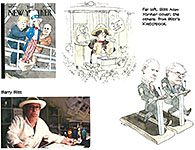
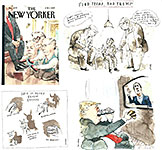
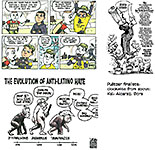

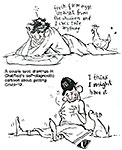
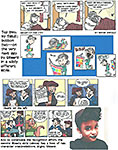
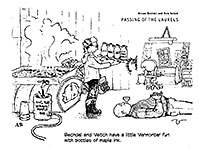
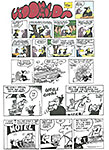

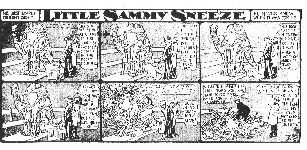
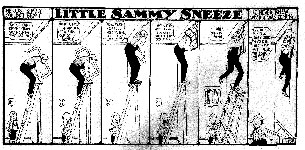

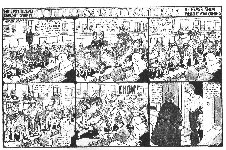
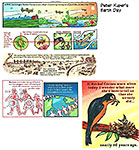
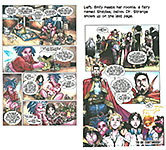

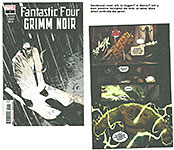
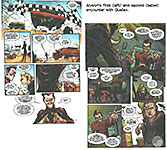
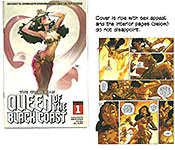
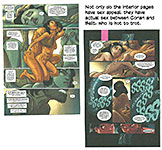
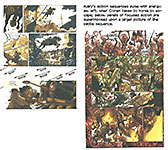

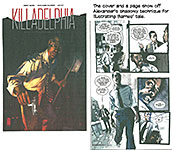
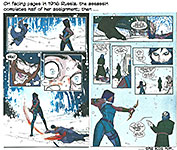
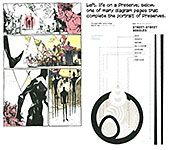

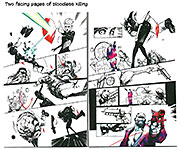
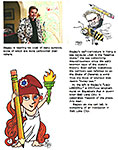
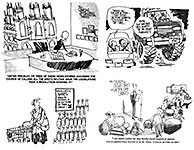

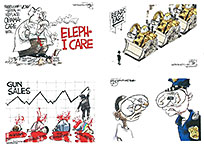
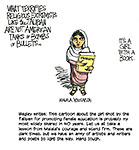
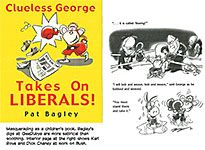
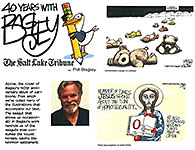
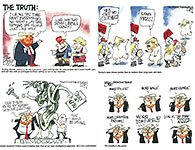
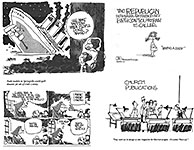
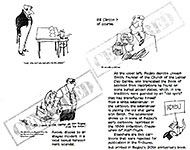
1.jpg)
2.jpg)
3.jpg)
4.jpg)
1.jpg)
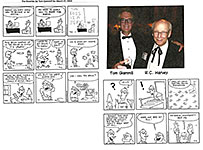
2.jpg)
3.jpg)
4.jpg)
5.jpg)
6.jpg)
7.jpg)
8.jpg)
9.jpg)
10.jpg)

